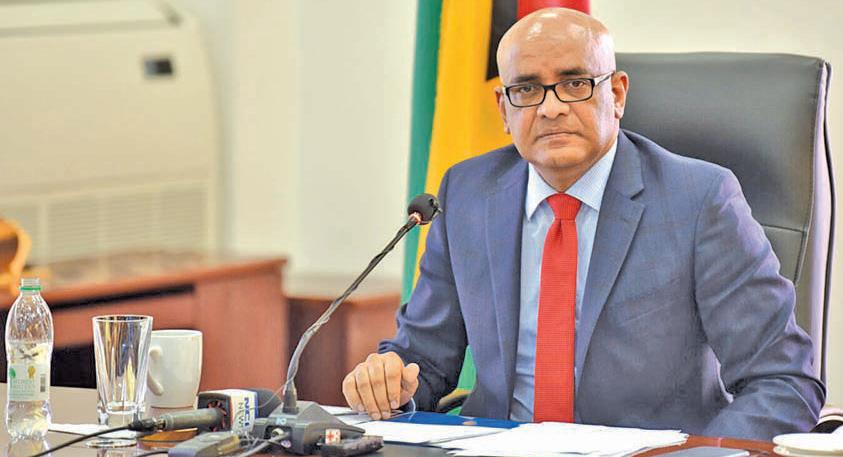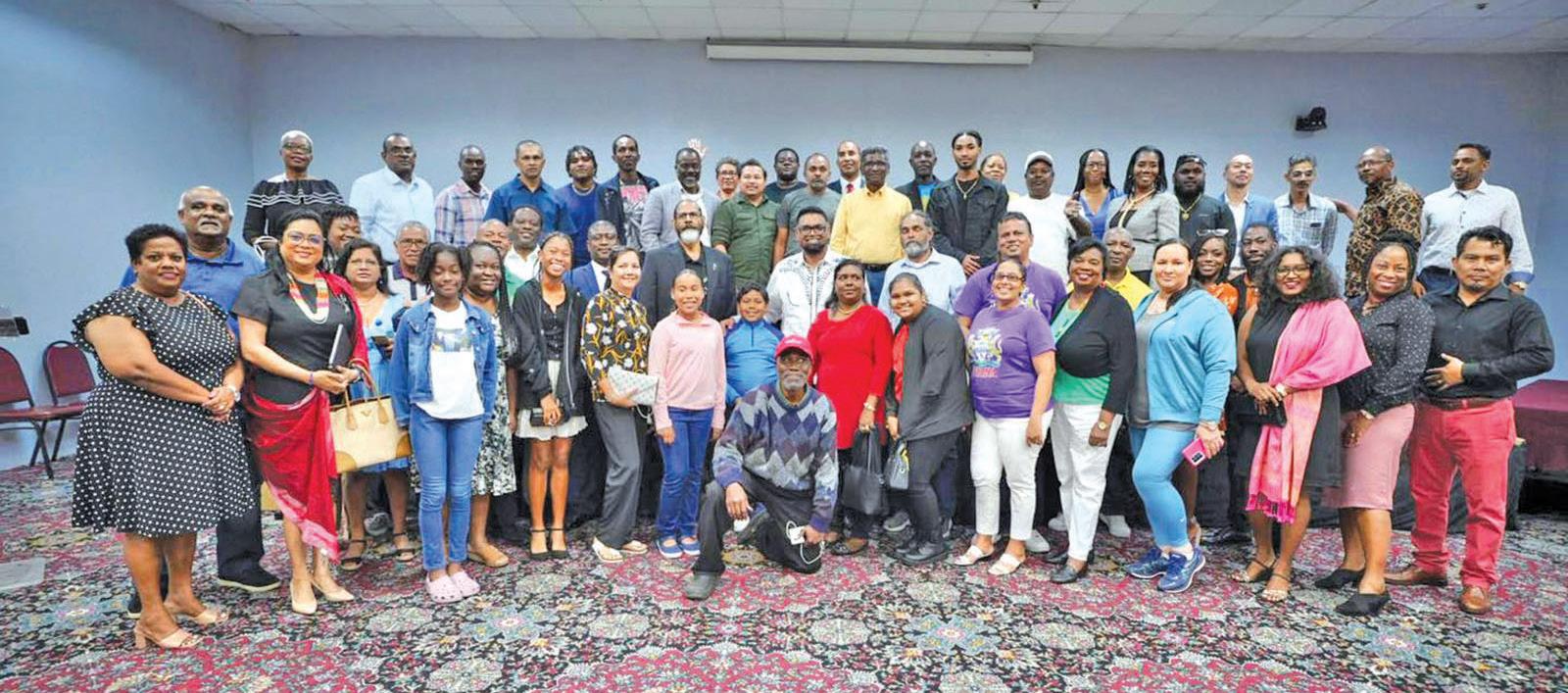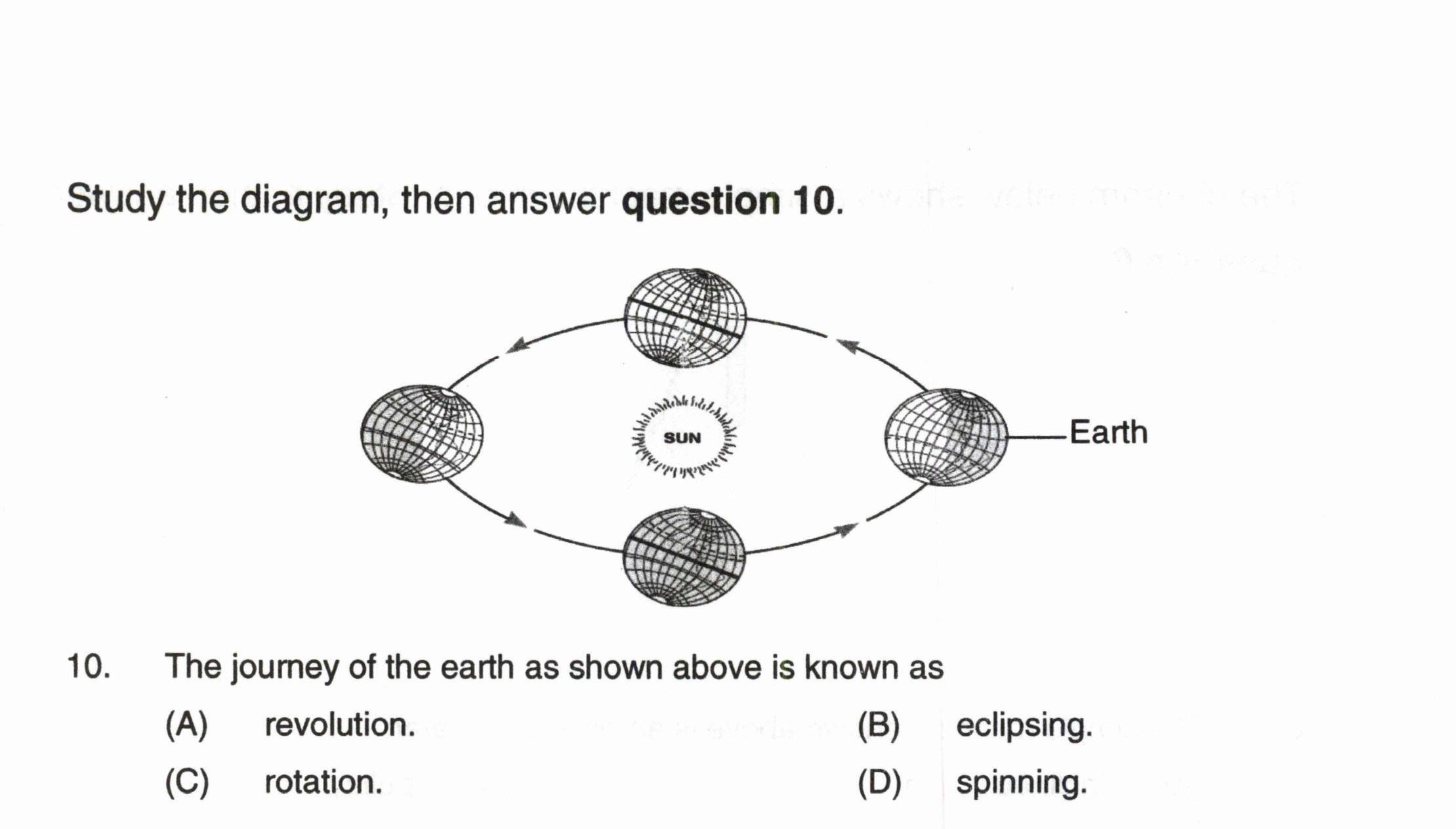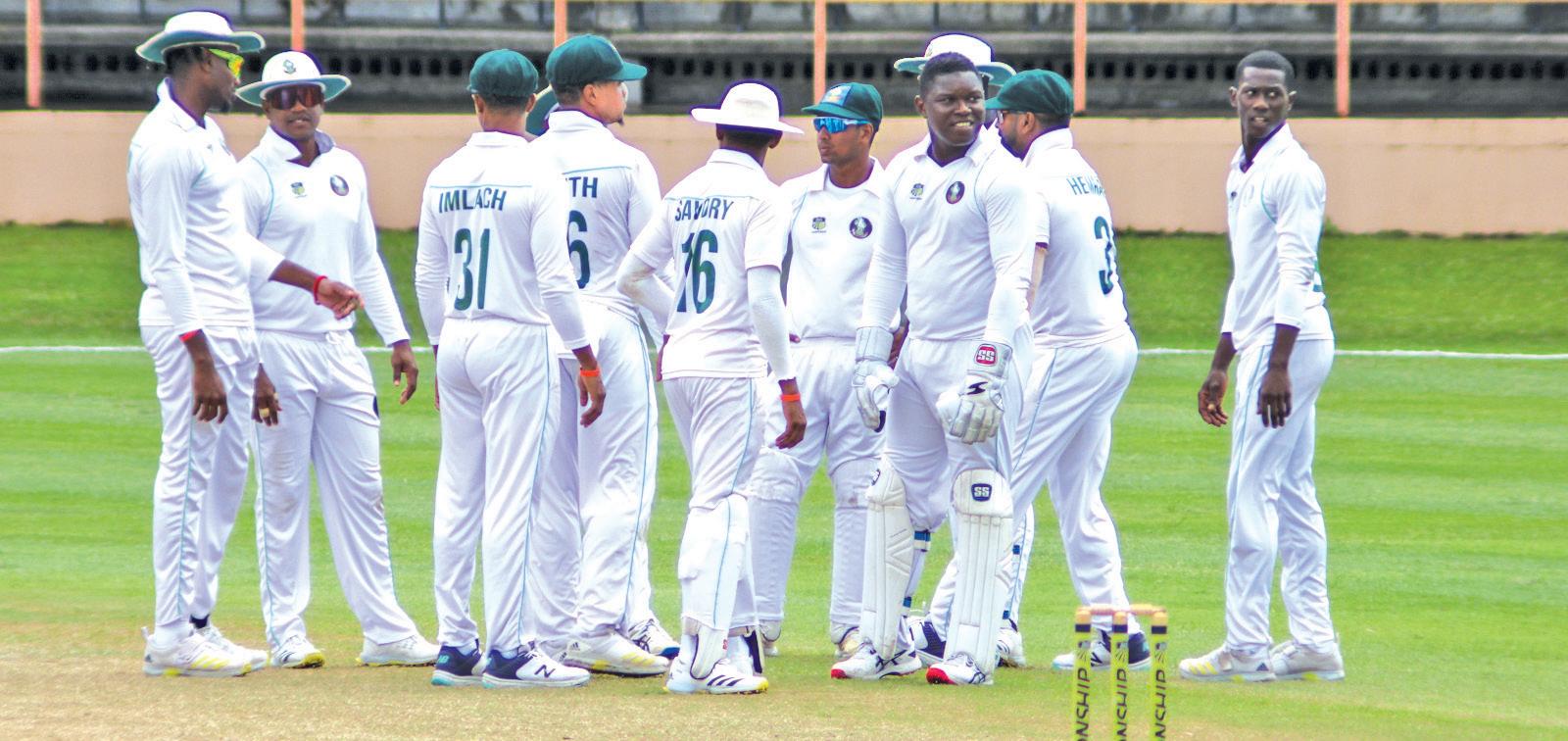
























Mallon explained.
Mallon also emphasised the company’s belief in this project, noting that ExxonMobil has over the years pursued its oil exploration campaign with lowered emissions, also a focal point of its operations.
“We’ve been investing while others were pulling back, which has been essential as we’ve gone through the crisis we’ve seen in recent years. And doing so with lowered emissions. Continually, year on year. And have made very strong statements about 2030 and 2050, in that regard across our company,” the executive said.

pillar of that is gas-to energy.”
While preparatory work has already started for the gas-to-energy project, the oil giant has not yet made a FID on the project. The delay is related to the Government review of the revised Lisa Field Development Plan (FDP), which has had to be updated so it can cater for the gas-to-energy project and the necessary infrastructure.
the pipeline would continue for approximately 25 kilometres to a Natural Gas Liquid (NGL) plant at Wales, West Bank Demerara.
ect, are expected to cost US$759.8 million and will be financed through sources that include budgets and loan financing.

AFinal Investment Decision (FID) by ExxonMobil on the gas-to-energy project, which it is investing over US$1 billion in to build out the pipeline and assorted infrastructure, is imminent. This is according to ExxonMobil Upstream Company President, Liam Mallon.

Mallon gave this update during an interview
with OilNOW. In the interview, he was asked when the company is likely to make its FID for the project. Mallon noted that the work towards making that decision is ongoing.
“I think it’s imminent. The work is ongoing. There are some necessities to complete, before the actual final investment decision. And we’re on track to achieve that very soon,”
“And fundamental to all of that, it’s part of our value system, is sustainable development in the countries we operate. And having been involved in Guyana from the very start, one of the key commitments that we made, is that we’re going to develop our business in this country in a way that provides sustainable benefits to people of Guyana. And a
The scope of Guyana’s gas-to-energy project consists of the construction of 225 kilometres of pipeline from the Liza field in the Stabroek Block offshore Guyana, where Exxon and its partners are currently producing oil.
It features approximately 200 kilometres of a subsea pipeline offshore that will run from Liza Destiny and Liza Unity floating production, storage and offloading (FPSO) vessels in the Stabroek Block to the shore. Upon landing on the West Coast Demerara (WCD) shore,
The pipeline would be 12 inches wide, and is expected to transport per day some 50 million standard cubic feet (mscfpd) of dry gas to the NGL plant, but it has the capacity to push as much as 120 mscfpd. The pipeline’s route onshore would follow the same path as the fibre optic cables, and will terminate at Hermitage, part of the Wales Development Zone (WDZ).
In Budget 2023, the gas-to-energy project received a $43.3 billion allocation. This allocation is in addition to the $24.6 billion injected into the start-up of the transformational project, which also includes the construction of a 300-megawatt (MW) Combined Cycle Power Plant at Wales, WBD.
The NGL and 300 MW power plant components of the gas-to-shore proj -
A sum of US$55 million per annum will be paid to ExxonMobil in amortisation costs for the pipelines to be installed in the gas-to-energy project, which will allow Guyana to in turn save and earn ten times that amount.
Guyana, with estimated recoverable natural gas reserves of over 17 trillion standard cubic feet, is likely to have the capacity to export as much as 50 million standard cubic feet of gas per day at some point in the future.
For perspective, this would make Guyana second only to Venezuela in the Region when it comes to estimated gas reserves. And Guyana is planning to make full use of its gas, formulating a gas utilisation plan as it continues work on the transformative gas-to-energy project.
project part of company’sExxon Upstream Company President Liam Mallon

The Demerara Harbour Bridge will be closed to vehicular traffic on:
Monday, Feb 20 – 04:15h to 05:45h and Tuesday, Feb 21 – 04:15h – 05:45h.
The Berbice Bridge will be closed to vehicular traffic on:
Monday, Feb 20 – 16:40h – 18:10h and Tuesday, Feb 21 – 05:05h – 06:35h.










Parika and Supenaam departure times – 05:00h, 10:00h-12:00h, 16:00h, 18:30h daily.

There will be thundery showers during the day and night. Temperatures should range between 22 degrees Celsius and 29 degrees Celsius.

Winds: North-Easterly between 2.23 metres and 5.36 metres.

High Tide: 17:02h reaching a maximum height of 2.84 metres.
Low Tide: 10:36 and 23:11h reaching minimum heights of 0.49 metre and 0.37 metre.

Climate adaptation measures, a necessary part of Guyana’s sustainable development plans as the fallout from climate change continues to be felt by the most vulnerable countries, could cost Guyana over US$2 billion.

This is according to Vice President Bharrat Jagdeo, who recently said that while the price for preparing Guyana’s coastline for the dangers of climate change is a hefty one, some of the funds can and will be sourced from the sale of carbon credits.
“The proceeds will be used to do some of the things we’ve identified in our expanded LCDS. The initial LCDS focused on mainly the forests, the new one on biodiversity, on integrated water management, on adaptation, the marine economy, and so the significant amount of funds required for adaptation, over maybe US$2 billion in Guyana’s case, just for flood control and water management.”
“That’s our biggest vulnerability. Some of the climate funds will be used for that purpose, some will come from the oil and gas industry. We can’t wait for climate funds or adaptation funds to come through the global mechanism. I think most countries in the Region are waiting for that and it will be a long wait,” Jagdeo said.
Last year, Guyana signed a historic, multi-year US$750 million agreement with Hess Corporation for the purchase of 37.5 million carbon credits. Guyana is, in fact, the first country to conclude the Architecture for REDD+ Transactions (ART) process of certifying its forest carbon.
According to Jagdeo, however, they are continuing to work at the international levels to improve on the prices ranging from US$15 to US$25 per tonne that Guyana secured

through this agreement. He explained that negotiations are continuing at the level of the United Nations Framework Convention on Climate Change (UNFCCC).
“Globally we’re pushing the UNFCCC negotiations, to create that room. Because if we can have a compliance market there, the prices would escalate. We got really good prices at $15 per tonne of carbon for the 2016 to 2020 period, it will be $20 for 2021 to 2025 and $25 per tonne between 2026 and 2030.”
“So those are good prices, compared to what is in the voluntary markets now. But it has the potential to go to $80, $90 per tonne. So potentially, this could become a $4, $5 billion deal, depending on if its traded upwards,” the Vice President said.

Guyana’s serialised


credits, listed on ART’s public registry, are available to buyers on the global carbon market, including for use by airlines for compliance with the International Civil Aviation Organisation’s global emission reduction programme, CORSIA, as well as for use toward voluntary corporate climate commitments.
Guyana’s completion of the ART process paved the way for other Governments that are looking to receive carbon market finance for success in protecting and restoring forests. At the time Guyana was issued with the credits, 14 other countries and large sub-national jurisdictions are working toward their own issuances of TREES credits.
ART, which is in charge of certifying forest carbon credits so that they can be sold on the international market, had announced
its approval in January of Guyana’s registration for 2021 to 2025, as well as the monitoring report for Guyana’s forests.
In a statement, ART noted that it approved these two documents for Guyana and that they are now available for stakeholder comments which must be submitted within 30 days. The first document is a TREES (The REDD+ Environmental Excellence Standard) registration document for 2021 to 2025, while the second is a TREES monitoring report for 2021.
ART’s approval of Guyana’s 2021-2025 registration document and monitoring report are important follow ups on its approval last year of 33.47 million forest carbon credits for Guyana, dating from 20162020. These credits were verified by a third-party against ART’s robust environmental and social requirements. (G3)
News Hotline: 231-8063 Editorial: 231-0544, 223-7230, 223-7231, 225-7761
Marketing: 231-8064 Accounts: 225-6707
Mailing address: Queens Atlantic Investment Estate Industrial Site, Ruimveldt, Georgetown Email: news@guyanatimesgy.com, marketing@guyanatimesgy.com

Today is the 100th anniversary of the birth of Forbes Burnham, who, in the words of Dr Walter Rodney, established a dictatorship in Guyana. Rodney described the nature of the dictatorship in 1979, the year before he was assassinated at the behest of Burnham according to a CoI. According to Rodney, “By definition, the dictator is responsible to no one, no organisation, to no social institution…(and)… surround themselves with mediocrities and lackeys – that is to say, by men and women with little competence and integrity who maintain their positions though cunning, opportunism and boot-licking in relationship to the dictator. In relationship to the people, these stooges of the dictator become tyrants, who imitate as best as they can, the intolerant and despotic behaviour of the big boss.
“The Burnham dictatorship has masked and camouflaged itself. It would prefer that its vices be hidden from the public. Why is this? Men in the past have boasted of being dictators….like Idi Amin. (But) The world has come to shun racist regimes…and all dictatorial governments. This climate of international opinion offers the first explanation as to why the Burnham dictatorship prefers to remain disguised.
“The Burnham dictatorship presents itself as its own opposite…as a democracy….(like) Hitler who subverted German bourgeois democracy in the 1930s. Burnham has taken a similar road to power – subverting the democratic system of which he was part in 1953. Hitler had a mad wish to rule the world. For this reason, he is generally described as a megalomaniac…Burnham’s megalomania is closer to comedy and farce. It takes the form of wearing a General’s uniform and hoping that the army will conquer his own people.
“Like all classic dictatorships, that which exists in Guyana has fostered the cult of the personality. The minority PNC regime has used all manner of tricks and gimmicks to make the “Comrade Leader” appear to be a demi-god. (Like) on the exercise books of school children, the face of the reigning English Monarch was simply replaced by that of the Prime Minister. (There is also) the highly personalised nature of the dictatorship. The dictator and his cronies make it their business to hire and fire….the state control over the economy was the main weapon used to keep people in line… (and decide) who to prosecute in the courts…
“Burnham encourages around himself individuals who are weak or corrupt, because he then exercises vicious control over them….On the international scene, Burnham could never be a powerful force. But he has proved crafty and cunning in achieving his ends within Guyana. An old woman at Bourda shouted at a recent political meeting that “Burnham mek Satan cry!”

“The Burnham dictatorship crept up upon Guyanese people like a thief in the night. His violations of human rights were frequent, but they were sufficiently gradual that many persons did not realise what was going on until it was too late.”
“We have said before that the Burnham dictatorship would prefer to hide under the disguise of being a democracy. Elections have not been abolished; instead they have been rigged in such a way as to become a complete mockery of the most fundamental of rights – the right to self-determination and free choice of one’s government. The rigged elections of 1968 and 1973 and the amazing referendum fraud of July 1978 all indicate that Guyanese people have not chosen the PNC clique. The regime holds power by armed force. Guyanese are finding from their own experience that the dictatorship hates to be reminded that it is a dictatorship. To expose the dictatorship, the first step is to denounce the government as illegal and illegitimate.”
“Psychologically, the domination of the dictator has to be rejected. The population must learn to despise the falsehoods which surround the man; they must refuse to accept that he has any halo of greatness around him… Our language (describing Burnham) must express not only ridicule but anger and disgust. Guyana has seen the “Burnham Touch” – anything he touches turns to shit!”
Dear Editor, The International Energy Conference & Expo Guyana 2023 concluded yesterday at the Marriott Hotel in Georgetown. Without any doubt, the conference was a success, and congratulations are in order for Anthony J Whyte and Kurt Baboolall, Chairman, and CEO of the conference, respectively.
The Conference was graced by several regional leaders including President Santokhi of Suriname (virtual presentation), Dr Keith Rowley of Trinidad, Dr Ralph Gonsalves, Prime Minister of St Vincent and the Grenadines, and Iván Duque Márquez, former President of Colombia.
Among the plethora of themes and lines of discussion at the conference, two salient points need to be highlighted. The first is internal and concerns the domestic macro-economic fundamentals of the Guyanese economy.
On this score, participants were able to clearly see continuity and stability in the current Administration’s monetary and fiscal policies. Of particular significance is the budgetary commitments to infrastructure geared towards oil and gas and beyond.
Key Administration officials, including President Ali, Vice President Jagdeo, Prime Minister Mark Phillips, and Finance Minister Ashni Singh, emphasised the need to continue with an aggressive capital expenditure programme in order to put in place the requisite roads, bridges, ports, air trans-
port facilities, and so on, necessary for the oil and gas sector, as well both hard and soft infrastructure in agriculture, tourism, housing, education, and healthcare.

It must be noted that continuity here refers to the current Administration adhering to its election manifesto since coming into office in August 2020.
Compared to the APNU/ AFC, there is actually a major shift. In 2019, for instance, the APNU/AFC committed only 22.7% to capital expenditure, with 77% going to current expenditures (or consumption). By contrast the 2023 budget has committed 49.6% to capital expenditure, with 50.4% dedicated to current expenditure.
The second major development was the strong investor confidence not only for the oil and gas sector, but for other areas of economic “takeoff”. Speaker after speaker noted that “all eyes are on Guyana”. Among them were John Hess (CEO, Hess Corp), Liam Mallon (ExxonMobil Upstream Company), Alistair Routledge (President, ExxonMobil, Guyana), Liu Xiaoxiang (President of CNOOC), Jon Charles Rhodes (Guyana Country Director, Baker Hughes), Dr Pryia Marajh (Board Director, Touchstone Exploration), Orlando C Segovia (CEO, Frontera Energy), and among others, Dr Thackwray Driver (President & CEO, The Energy Chamber of Trinidad and Tobago).
UK High Commissioner to Guyana Jane Miller,
The World Bank Representative for Guyana and Suriname, Diletta Doretti, and NYU Professor Amy M Jaffe, also spoke about the configuration of global, regional, and domestic factors propelling Guyana forward.
Just as important, a slew of speakers from the Guyanese business community such as Lars Mangal and Nicholas Deygoo, and heads of agencies and other high offices including Dr Mahender Sharma, Dr Peter Ramsaroop, Pradeepa Bholanauth, Shyam Nokta, Dr Paulette Bynoe, Dr Natasha Gaskin-Peters, and Rabin Chandrapal, spoke to the gathering momentum of the Guyanese economy. Minister of Natural Resources Vickram Bharrat provided a detailed nuts-and-bolts overview of where things stand, and where they are heading in the O&G sector.
One of the key areas of focus at the conference was the skills shortage in the country and the massive opportunities now open to the younger generation of Guyanese. Quite fittingly, the closing session yesterday was a “Youth Engagement Forum” which saw students from Queen’s College, Anna Regina Secondary, and SVN Secondary (from Cornelia Ida, WCD) in the audience. They were meaningfully engaged by a selection of Guyana’s best and brightest of the younger generation – Joel Bhagwandin, Dr Rosh Khan, Grace Huston, and Leonard Hoppie.
Two further observations are in order. Firstly,
President Ali was emphatic that a new global coalition is needed to meet the challenges of climate change, food security, and energy security. He warned against “self-righteous” attempts intended to stifle economic development in the small and developing economies of the Global South.
Secondly, Vice President Jagdeo was insistent that oil and gas development allows for a winwin between the oil majors and the people of Guyana. He was clear that future contracts in hydrocarbons will not repeat the mistakes made by the APNU/ AFC in 2016. Jagdeo noted that future oil contracts will have a minimum of 10% royalties (compared to the current 2%), a reduction in cost recovery to 65% from the current 75%, and an equal split in profit oil. He noted that the local content legislation has managed to claw-back (from EEPGL) benefits to Guyanese contractors and workers, and this, despite stiff resistance from EEPGL when that body of legislation was first articulated.
The week-long 2023 International Energy Conference & Expo in Guyana was a raving success. It brough Government leaders, investors, suppliers, contractors and vendors, academics, youths, and the general public into sustained, face-to-face conversations, about the economic developments and opportunities in Guyana.
Sincerely, Dr
Randolph PersaudDear Editor, Recently, a labour leader attacked the Government and another union over assistance to GuySuCo, signalling a lack of solidarity among unions and their leaders. Workers across Guyana especially in large industries complain about low salaries and high inflation preventing them from having a higher standard of living. They would do well with better representation of unions and political benefactors to champion their interests. The working class has been affected by inadequate wages. Farmers and non-unionised workers are also suffering as a result of lost crops over the last two years. The Government did assist the farmers and should consider providing them more assistance in light of recent losses attributed to bad weather that prevented harvesting. Politicians should pro-

vide the working class and farmers with more assistance.
Trade unions and their leaders across the political divide have been raising issues of the livelihood of workers with limited success of recently. Dr Jagan was among the most effective in championing workers’ interests and getting salary increments for workers. Governments and trade unions always heralded the contributions of workers but did little to champion their interests the way Jagan did. Union leaders and politicians should take their cue from him on how to represent the working class.
Many workers have no voice. They are not unionised and by extension have no organisation to advocate for their interests.
Workers, especially in relatively new large-scale sectors like oil, lumbering, mining, fishing, etc are

not unionised to gain representation. Government should ensure that workers in emerging sectors be allowed to unionise. Some workers across many industries, including those who are unionised, complain in conversations with me that they are not getting fair pay for their productivity. They say salaries are not keeping pace with the rapid rise in inflation making it a challenge to provide for their families.
But are businesses earning enough margins to afford higher salaries?
Inflation is also impacting their business. Some businesses, including major companies, are struggling to meet payroll. In opposition to workers’ demands, management of businesses including major companies say they can’t afford higher salaries because their profit margin is low. The only access to tax returns and or audits can determine a

company’s profitability and affordability of higher wages.
If companies don’t treat workers well, the latter will not maximise output. There must be fair compensation. Some companies give workers fair compensation – bonuses and a share in profits. But workers should not have to depend on the generosity of bosses for their salaries; they must be paid what they deserve in line with their productivity. They cannot make unrealistic demands that will drive business out of production. And they cannot have inordinately high expectations. Businesses can only afford salary expenses within their margin of profit.
There must be negotiation (a give and take) between management and workers (if unionised) for a fair package that the companies can pay out and still earn a profit. The agencies
or organisations that represent farmers and those who are employed in the farming sector should also demand more resources from the Government. Many farmers suffered huge losses over the last two years and their workers suffered enormously as a result of failed harvesting.
Government must play the role of an honest broker enforcing the laws and ensuring workers and farmers and their employees are treated fairly. It is noted that when in opposition, political parties tend to champion higher salaries for Government workers and greater resources for farming. But once in Government, they oppose wage increases and limit resources to farmers. Farmers, unions, and workers’ demands are not always echoed in Parliament after elections.
The unions’ stance and farmers and their employ-
ees are most valued and appreciated during election time. After that, they are ignored by politicians. The same with the working class! Regrettably, unions and the working class, and the farming community tend to be politically aligned and divided on racial lines. There is little inter-union solidarity as a result of politics. A recent case in point is the attack on the Government for aiding the ailing sugar industry which thousands depend on for a living. Lack of inter-union solidarity and criticism of each other hurt the effectiveness of labour to make demands on the Government for higher wages and better working conditions. Farmers need greater support from the Government to mitigate losses over the last several crops.
Yours truly, Vishnu Bisram

Dear Editor, Guyana is facing a complex set of challenges and opportunities in the face of decreasing demand for oil worldwide. One of the biggest challenges is the decreasing demand for oil worldwide, driven by a variety of factors, including the rise of renewable energy sources and the increasing awareness of the environmental impact of fossil fuels. This trend has led to a decline in oil prices, which has affected the profitability of oil companies worldwide
and forced them to cut back on investment in new projects.
The reality is the market for oil and gas is shrinking. That is a reality we should be very aware of as an oil-producing nation. Guyana doesn't operate in a silo, policy changes around the world affect us. There has been a growing trend in recent years towards reducing and banning the use of fossil fuels in an effort to combat climate change and transition to more sustainable energy
sources. Here are a few examples of recent policies that have been implemented to reduce or ban fossil fuels:
In 2020, the UK announced that it would ban the sale of new gasoline and diesel cars and vans by 2030, with hybrid vehicles to follow in 2035. This policy is part of the UK's efforts to achieve net-zero emissions by 2050. Denmark is aiming to phase out the use of fossil fuels entirely by 2050, and has imple-
mented a range of policies to achieve this goal.
These include a tax on fossil fuels, incentives for electric vehicles, and a requirement that all new buildings meet energy efficiency standards. France has announced that it will ban the sale of new gasoline and diesel cars by 2030, as part of its efforts to reduce greenhouse gas emissions and improve air quality.
Overall, these policies represent a growing trend
towards reducing and banning the use of fossil fuels in order to mitigate the impacts of climate change and transition to more sustainable energy sources. The current Administration understands this very well. But every day we can see utterances in Opposition to the pace of development. We cannot miss this golden opportunity. There are too many that
do not understand the entirety of the situation. We have to move now as the window is closing. We have at best three decades to maximise extraction. We have to “move fast and break things” or forever lose this opportunity and that is what’s happening.
With regards, Anil
Sukhdeo


















The Education Ministry and the Guyana Police Force have launched separate investigations into the attack on students and teachers at the Woodley Park Secondary School, West Coast Berbice.


On Friday, students came under attack by young residents of the Woodley Park Village, who walked into the school and verbally as well as physically assaulted them.
Education Minister Priya Manickchand on Sunday said she was made aware of this very serious allegation of verbal and physical abuse of students accompanied by alleged unacceptable and criminal racist language regarding children of the Woodley Park school.

“This will be fully investigated both by the Guyana Police Force as well as the Regional Education Department and as soon as those findings are available, I will make them public,” she assured.



Manickchand added, “In the meanwhile, every action will be taken to keep
our children attending that school safe. And anyone who attempts to interfere with that will be dealt with condignly.”
Also on Sunday, the Home Affairs Ministry issued a statement on the incident as well, indicating that the Head Teacher and students of the Woodley Park Secondary School were engaged by the Police.
It was noted that based on the information received, two individuals were contacted, one an adult and the other a child.
“The Police have already begun an investigation into the matter, and one person is currently in custody,” the Ministry said.
Additionally, a planned engagement between the Police, teachers, and students of Woodley Park Secondary will be held to further aid with the investigation.
“The Ministry of Home Affairs condemns in the strongest possible terms any or all occurrence of racially motivated attacks, particularly on our schoolchildren.”
In a video that was shared on social media, teachers and students, and even some parents, were seen in the compound of the Woodley Park Secondary

School as a group of males armed with pieces of wood walked around the compound. They were confronted by parents and teachers and made to leave the school compound. In one of the videos, a male student was heard saying, “Miss, you just see that big man come and cuff me, right?”.
On Saturday, the People’s National Congress
Reform – the leading party in the parliamentary Opposition coalition – called for the intervention of the Ministries of Education and Home Affairs to investigate this incident and put mechanisms in place to ensure that parents and students can feel safe returning to school. (G8)

Two bail applications have been refused for businessman Khemadatt Persaud, who is accused of attempting to murder his 36-yearold ex-wife. The first was by Magistrate Rabindranauth Singh before whom he appeared on Wednesday, February 1.
The 55-year-old man of Vryheid Village, West Canje, Berbice, was not required to plead to the indictable charge which alleged that on January 30, he unlawfully and maliciously wounded Deoranie Badal called “Marcy”, with the intent to murder her.
His lawyer, Senior Counsel Murseline Bacchus then filed a bail application on his behalf at the

High Court in Berbice. The matter came up last Wednesday before Justice Navindra Singh, who declined Persaud’s request for his pre-trial liberty.
State Counsel Nafeeza Baig appeared for the prose-
cution. As such, the accused will remain on remand as his case continues at the Whim Magistrate’s Court.
Guyana Times had previously reported that 36-year-old Badal sustained chop wounds to her head.

This publication has reported that, on the day in question, Persaud allegedly chopped Badal about her body with a cutlass, resulting in her sustaining severe injuries to her head.
Reports are that at around 13:00h at Rose Hall Town in East Berbice, the woman – who works as a junior manager at Nand Persaud Berbice Rice Mills – was at a wash bay when her ex-reputed husband arrived and began chopping her to the head and body.
A Police rank who was at the wash bay intervened and rushed the injured woman to the hospital. At the time of the incident, Persaud and Badal had been separated for over three months. (G1)

If he were alive, (a VERY scary thought!!) Forbes Burnham would’ve been 100 years old today!! The Kitty where he was born in 1923 was an East Coast village so Burnham wasn’t a “town boy” – and that meant something when he attended the “town schools” like Central and Queen’s. He was ambitious from childhood – as related by his sister Jessie early on in her eerily prophetic pamphlet, “Beware my brother Forbes”!!
“BEWARE, I say, of “MY BROTHER FORBES.” His motto is the personal ends of power justify ANY means used to achieve them. His Bible is The Prince by Machiavelli. And we, should he come to power, will be only pawns in his endless game of self-advancement…This burning ambition, if channelled properly, could have made him one of our country’s great Statesmen-leaders. It would have, had he coupled this ambition with a genuine concern for the welfare and needs of the people, given him all he sought, in life. But along with ambition, he developed certain slickness, a sly glibness. He began even as a boy, to depend more and more on his skills with words to achieve his goals.”
His ambition would see him split the national movement that the PPP had become by 1953 – knowing fully well it could open up the latent racial divisions. He knew because he took care to attempt to recreate the diverse racial leadership Cheddi and others had assembled from 1947 while he was studying in England. But a division is a DIVISION – especially when his actions soon drove out most of the Indian leaders who’d “sided” with him. His followers have tried to pin the subsequent ethnic voting on Jagan because one competing leader –Debedin – had given this an “Indian name” – Aapan Jhaat (vote for your own). But in reality both leaders understood the dangers of division – yet Burnham created the reality for sheer personal ambition!!
ALot 10 Bounty Hall Public Road, Essequibo Coast housewife caught with a quantity of cocaine at her home has been jailed for four years.

Forty-year-old Brenda Charles called “Shameena”

appeared before Magistrate Crystal Lambert at the Suddie Magistrate’s Court last Friday where a charge for the offence of possession of a narcotic for the purpose of trafficking was read to her.
To the charge laid con-
trary to Section 5 (1) (a) (i) of the Narcotic Drug and Psychotropic Substance (Control) Act, Charles pleaded guilty, admitting that on February 16, she trafficked 451 grams of cocaine. In addition to being served a jail sentence, she was also fined $1,353,000.
On the day in question, Police ranks acting on information went to the woman’s home.
As the Police arrived at the location, the woman was in the upper flat of the home and was informed that they were there to search for narcotics and unlawful articles, to which she agreed.
The woman immediately went to her sofa and took out a white and red ceramic plate containing a quantity of a whitish rock-like substance and handed it over to the Police ranks along with an additional 39 pieces of a whitish rock-like substance.


She was told of the offence committed and cautioned. She replied: “Sir, it’s me own, ah buy it from a man.” She was then arrested and escorted to the Anna Regina Police Station. (G1)
There’s no question that by colonial British standards, Burnham was “bright” – he always did well on exams. But his greatest failure was his insistence on treating people as means – means to further HIS ambitions – and not as ends to be developed for themselves. He was – as the old people say – a “smart fly”: but they also pointed out that “all smart flies does end up pan cow backside”!! Unfortunately for us Guyanese, his ambition made him “tie bundle” with the colonial forces – which ensured that ultimately, he was just a puppet on strings that could always be yanked!!
From being one of the British Colonies in the Caribbean blessed with the most resources, he made our country plummet just above the poster boy of poverty – Haiti. That’s his legacy and no amount of whitewashing can change that!!
…Carter
Interestingly, US President Jimmy Carter – who played such a critical role in rebuilding our democracy that Burnham had eviscerated – is in the news. He was born the year after Burnham, we don’t have to be rocket scientists to know he’s pushing a hundred. But time has taken its toll and we’re told that after several hospitalisations, he’s decided to spend his remaining days in hospice care in his Plains Georgia home – from where as a peanut farmer he became President!!
Carter must be remembered by Guyanese and given credit for he spared us what Haiti’s presently suffering from – total anarchy, death and destruction. It was Carter who brokered the agreement for free and fair elections in 1992 with Desmond Hoyte. And when PNC supporters – egged on by PNC hardliners like Hamilton Green –attacked the GECOM headquarters when it became clear that the PNC was losing, it was Carter who made that call to President Bush.
The PNC have learnt nothing: they tried (thankfully, unsuccessfully) to repeat this in 2020!!
…and Mash
Green says Burnham proposed Feb 23 for independence – but the Brits chose May 24. Which Burnham rejected because it was Queen Victoria’s birthday. He proposed May 26, because he forgot that was the date of the Wismar Massacre??
Judges are held to a very high standard.
So, should they not be held accountable when they break the very laws they have sworn to uphold? Attorney General and Legal Affairs Minister Anil Nandlall’s answer to this question is, of course, yes.
According to the Senior Counsel, Judges have been repeatedly delinquent in complying with the Time Limit for Judicial Decisions Act – a law enacted over a decade ago which, inter alia, sets the time limit for the delivery of oral or written decisions in civil cases.
He made this disclosure while recently discussing the status of constitutional reform and electoral changes in Guyana on the social media programme The Guyana Dialogue.
Section 4 (1) of the Act states: “A Judge who presides at the trial of a civil case shall give a written or an oral decision and reasons for the decision at the conclusion of the hearing of the case or as soon as possible after the conclusion of the hearing but not later than 120 days from the date of the conclusion of the hearing.”
Section 5 of the statute further states: “Where the Court of Appeal or the Full Court hears an appeal, a Judge on behalf of the Court or each Judge of the Court shall give a written or an oral decision and reasons

Service Commission (JSC) – the constitutional body responsible for the appointment of Judges – to ensure that vacancies are filled in the Judiciary and the Magistracy, Nandlall assured that “every effort” is being made to establish the JSC which expired in September 2017.

Act,” Section 6 of the Time Limit for Judicial Decisions Act.
for the decision at the conclusion of the hearing of the appeal or as soon as possible after the conclusion of the hearing but not less than 30 days from the date of conclusion of the hearing.”

The Act, which also requires Justices to do a report in relation to their compliance with that very law and table same in the National Assembly annually, applies to Judges of the Court of Appeal, High Court, and the Full Court.

But there has been disregard for this law, the Attorney General has emphasised, stating, “that legislation has been completely ignored.”
Going forward, he stressed that this cannot continue in Guyana’s modern democracy.
While he admitted that there is a shortage of Judges and no Judicial
And once the JSC is reconstituted, Nandlall said Judges will be appointed as there is a Bill in the National Assembly that is intended to increase the number of Judges at the Court of Appeal threefold. “We are going to appoint an abundance of Judges required for the task at hand,” he assured. “Once we accomplish that, then I believe that the Judiciary should be held accountable and those laws will have to be enforced and persons’ constitutional right to have a fair trial within a reasonable time,” he said while pointing out that the Judiciary is a very important, and highly self-regulatory constitutional body.
According to him, the workings of the Judiciary would be reviewed. “The way the Judiciary functions. There are mechanisms in place that hold the Judiciary to certain standards.”
Like every other institution in the modern world, the Attorney General explained that the Judiciary is answerable and must be held accountable for how it conducts itself and how it conducts its business.
In this regard, speed and efficiency, he noted, are part and parcel of a justice system, reminding of the aphorism “justice delayed is justice denied”.
According to the Legal Affairs Minister, in the same manner, wherein the Executive and Legislature are under pressure to be more accountable, efficient, and transparent in their daily functions, the Judiciary must similarly be pressured.
The Executive, Legislature, and Judiciary are the three branches of Government. Under the separation of powers—a doctrine of constitutional law—the mechanisms of governance are divided into these three branches, each with separate, independent powers and responsibilities.
“The same way
Parliament is being pressured to deliver more legislation, to have greater scrutiny over Executive conduct, for the Public Accounts Committee to delve deeper into the Auditor General’s Report so that the financial irregularities are exposed and persons are charged…. the same way the Judiciary has to be made subject to similar initiatives in order to extract from it, the level of transparency and efficiency that is consistent with modern realities in a democratic society,” he reasoned.
“In accordance with Article 197 (3) of the Constitution, a Judge may be removed from office for, among other reasons, persistently failing to give written or oral decision and reasons for the decisions within the time specified in this
The above constitutional provision sets out that a Judge may be removed from office only for inability to perform functions of his or her office (whether arising from infirmity of mind or body or any other cause) or for misbehaviour or for persistently not writing decisions or for continuously failing to give decisions and reasons therefor within such time as may be specified by Parliament.
This is not the first time the Attorney General has called on Judges to obey the Time Limit for Judicial Decisions Act; a similar appeal was made by him in October 2021.
Weighing in on the issue, Senior Counsel KA JumanYassin had told another section of the media that ensuring compliance with this Act is the sole responsibility of the Chancellor of the Judiciary.
In addition to time limits for issuing decisions and penalties for non-compliance, the Act provides for a case to be tried as expeditiously as possible in an endeavour to conclude the case within such time as the complexity and the relevant evidence necessitate. (G1)
“completely”
timeframe
issuing
…says when more Judges are appointed, Judiciary would be held accountableAttorney General Anil Nandlall, SC
Police in Region Seven (Cuyuni-Mazaruni) found a gun along with ammunition at the Barakat Backdam after acting on information received.
Reports are that at about 11:25h on Friday, Police ranks were on patrol, when they received information about the location of a firearm. As a result, the ranks went to an abandoned camp and conducted a search.
During the search, a 4” PVC pipe was seen in the abandoned house. Upon inspection, one of the ranks found a 12-gauge shotgun

along with ten matching cartridges wrapped in a salt bag and stashed inside the pipe.
There was no serial number or maker’s name visible
on the weapon. Signs of recent activity were also observed in the area. No arrest was made.
Investigations are in progress. (G9)

The body of a man was on Sunday morning found submerged in a trench at Dazzle Scheme on the East Coast of Demerara (ECD).
The man has only been identified as “Fiah” of Second Street, Dazzle Scheme, ECD.
Reports are that the man was last seen alive by villagers on Saturday evening imbibing alcohol. However, on Sunday morning, his lifeless body was discovered in the trench, a house away from his home.
Persons are of the be-
lief that man in his drunken state, might have been making his way home when he ended up in the trench, and was unable to get out.
Following the discovery, the Police were called to the scene and an investigation has been launched.
More than a week ago, a similar incident occurred where the lifeless body of a 45-year-old mechanic was pulled from a trench at Ogle, ECD.
The man, Kevin Singh, of Industry Crown Dam, ECD, is a known alcoholic and had
been reported missing after he left his home but never returned. Family members said Singh would usually leave his home for long periods, but after a considerable amount of time had passed and he did not return home, they realised something was amiss.

They had launched a search for him, but he had not been located hours after that search had commenced. However, the following day, the man’s body was spotted floating in a trench at Ogle. (G9)
An Essequibo Coast woman is now in Police custody after she allegedly stabbed her common-law husband to death in the wee hours of Sunday morning at Macknab, Lima Sands, Essequibo Coast, Region Two (Pomeroon-Supenaam).
Dead is Anthony Shivlall, popularly known as “Davie” of Lima Sands, Essequibo Coast.
Reports are that the 27-year-old man was stabbed at about 02:00h during an argument with his wife.
This newspaper was told that on Saturday, Shivlall and his wife were both at a birthday party for the teenager’s grandmother at the woman’s home at Macknab, Lima Sands.

The grandmother, Bernadine Williams, told investigators that at about 17:00h, the couple had an argument that resulted in the teenager leaving the party and going home. However, at about 02:00h on Saturday morning, the teenager returned to her grandmother’s house and asked for her husband.
According to Williams, she told her granddaughter that Shivlall was inside the lower flat of the house. The woman said her granddaughter went into the lower flat of the house, where she spent a while, which prompted her to make checks.
Police in a statement said that upon checking, the grandmother saw Shivlall lying on the ground, and her granddaughter was over him.
“She was stabbing him with a knife to his chest area, causing him to receive injuries, after which she ran east of the lower flat, exited and made good of her escape,” the Police said.
The matter was reported and the Police went to the scene. Detectives reported that they observed one stab wound on the victim’s left chest area, one stab wound to his lower right chest area, and one to his left hand.
Acting on information received, the Police arrested the suspect at her mother’s house in Macknab. Police said that the teen admitted to stabbing her husband. Shivlall’s body was escorted to the Suddie Public Hospital, where it was formally pronounced dead on arrival. The body is presently at the Suddie Hospital’s Mortuary awaiting a post-mortem examination.
(G9)
With a current debt to Gross Domestic Product (GDP) ratio of 24.6 per cent, Senior Minister in the Office of the Presidency with responsibility for Finance, Dr Ashni Singh has cited this as the result of the Government being extremely selective and strategic in how it borrows externally.
During his presentation at the recently concluded Guyana Energy Conference and Expo, Dr Singh revealed the debt-to-GDP ratio of 24.6 per cent to the applause of those present. This figure, according to the Finance Minister, is a regional best.
“We’ve been able over the years to bring public debt down. And today, Guyana’s public debt-to-GDP ratio stands at 24.6 per cent. I didn’t put a chart up with international comparisons, but many of you are familiar with these numbers.”
“You track them all around the world. You will no doubt recognise that a debt-to-GDP ratio of 24.6 per cent in fact, places Guyana ahead of almost every economy, certainly in this hemisphere. And puts us in a position where we have fairly
significant legroom to borrow,” Dr Singh said.
While Guyana is likely to have more opportunities to borrow, however, Dr Singh noted that the Government is being very strategic in its borrowing and focused on ensuring that these are good loans that will serve the country’s interest.


“But notwithstanding that, recognising the importance of maintaining a strong public sector balance sheet and very strong debt dynamics going forward, we’re extremely selective and careful about the new borrowing that we contract. Borrowing only for the purpose of making strategic investments,” the Finance Minister said.
“And good quality borrowing, so we still have in fact a strong portfolio with the multilateral and regional development institutions. We still have a strong pipeline of official borrowing, which means we are able in fact to finance our fiscal programme without recourse to expensive or uncompetitive borrowing.”
By comparing what a country owes with what it produces, the debt-to-GDP ratio indicates its abili-
ty to pay back its debts. A high debt-to-GDP ratio may make it more difficult for a country to pay external debts, and may lead creditors to seek higher interest rates when lending (or what is known as a bad loan).
The higher the debt-toGDP ratio, the less likely the country will pay back its debt and the higher its risk of default. A specific debt-toGDP ratio demonstrates an ideal position has not been agreed to, but instead, it is typically focused on the sus-
tainability of certain debt levels.
According to information contained in the Public Debt Annual Report of 2017, Guyana’s total public debtto-GDP had increased from 45.7 per cent, in 2016 to 46.2 per cent in 2017. The report had noted that the increase in the debt-to-GDP ratio was mainly caused by an increase in public debt stock as a result of increased disbursements from Guyana’s external creditors such as the Inter-American Development Bank (IDB); International Development Association (IDA); Caribbean Development Bank (CDB) and China Eximbank. At the end of 2020, the ratio of public debt-to-GDP was 47.4 per cent. However, it began to drop by 2021.
The United Nations, in an Economic Commission for Latin America and the Caribbean (ECLAC) report titled, “Preliminary Overview of the Economies of Latin America and the


Caribbean 2021,” had hailed Guyana’s gross public sector debt-to-GDP ratio of 36.6 per cent (at the time) as the lowest in the Region.
According to the commission report, this was 11 percentage points lower than the debt-to-GDP ratio at the end of 2020 and far lower than the regional average
debt level of 90.3 per cent of GDP.
According to the ECLAC report, Barbados’s debtto-GDP ratio of 145.6 per cent was the highest in the Region, followed by Suriname (121.8 per cent), Belize (120.3 per cent) and Dominica (100.4 per cent). (G3)



The People’s Progressive Party/ Civic (PPP/C) Government is cognisant of the need for attention to be paid to the development of Guyana’s riverine transportation system, with a view of dredging and deepening river channels so that more barges can traverse.
At least two highly placed Government officials have, over the past week, had to respond to questions during the Guyana Energy Conference and Expo about
the Government’s plans for riverine transportation.
When asked, Vice President Bharrat Jagdeo explained that the Low Carbon Development Strategy (LCDS) speaks to an integrated water management strategy that includes improving the riverine transportation system.
“When I say integrated water management strategy, as part of the LCDS, it’s water, portable water, water for agriculture, water for navigational purposes, it’s
water for fisheries purposes. That is the approach here. So integrated water management is not just for flood control, but it’s for water for all the purposes, including economic purposes.”
“Clearly that is important for us. How we navigate our rivers, use them for transport, and a whole range of other things. And the maritime economy, it includes mangroves and the riverine communities, not the blue economy alone where you look at the sea,”
Jagdeo explained.
Meanwhile, Senior Minister in the Office of the Presidency, with responsibility for Finance, Dr Ashni Singh also responded to a question from an attendee at the conference regarding the deepening rivers to aid in the passage of larger vessels.
It was pointed out that there are limitations when transporting sand from the upper Demerara mining areas on the barges, due to the depth of the river. The question was thus posed to the Finance Minister whether there are any plans to deepen the draft of the river.
The Finance Minister acknowledged the need for Guyana to accelerate the development of its transport network, in order to keep pace with Guyana’s economic development. And similar to the way the Government is moving to develop roads and bridges, the waterways are also in need of more in-
frastructural work.
“Historically, the depth of the river has been a constraint. The Demerara River in particular, has constraints in terms of the depth of its draft, both at the major port facilities at the mouth of the river and further down the river. We recognise this impediment; I couldn’t agree more that the question of dredging our key riverine areas is certainly foremost in our minds.”
“With the development of more port facilities at the mouth of the Demerara River, it’s going to be unavoidable that more is going to have to be done on dredging the mouth of the river further down and this is also a question that will have to be confronted with our other major rivers,” Dr Singh said.
Making reference to joint venture partners CGX Energy Inc and Frontera Energy’s plans to construct a deep-water port facili-
ty in Berbice, the Finance Minister noted that this project will have implications for the overall need to improve river transportation.
“Eventually the mouth of the Berbice River will also be home to deep water harbour facilities, which will also have implications for dredging of the rivers. So, it’s very much on the radar, I suppose the question is to find a sustainable model to ensure the rivers remain well dredged to promote competitive access to the port facility.”
CGX’s subsidiary, Grand Canal Industrial Estates Inc (GCIE), has been engaged in civil works related to the construction of the port, which intends to serve as an offshore supply base for the oil and gas industry, and as a multi-purpose terminal cargo handling base to service agricultural import/export, containerised and specialised cargo.

Members of the Providence Sunnatul Jamaat in collaboration with the management and staff of Mohamed’s Enterprise have accumulated $5 million in response to the Turkey/ Syria earthquake emergency appeal.

Two nations are reeling from a devastating 7.8 magnitude quake on February 6, 2023, which has resulted in thousands of fatalities, injuries to civilians, and destruction to infrastructure. According to international reports, the death toll in the neighbouring countries has surpassed 46,000 as of Sunday.
In a statement on Sunday, the organisers of this relief initiative expressed their gratitude to all the donors, supporters and well-wishers who have made a contribution to the effort.
“To date we have been able to accumulate the sum of G$5,000,000 (five million Guyana dollars) in response to this appeal. This donation in cash shall be forwarded through Human Concern International; a Canadian based social welfare and relief organisation, which has been in the forefront of alleviating the suffering of the less fortunate around the world for over forty years irrespective of ethnicity or creed,” the organisers said.
They added, “We all join in prayers for God-Almighty to grant patience and relief to the victims of this disaster as we sympathise and grieve for their loss of loved ones. Additionally, we call upon our fellow brothers in faith to mimic our appeal in their respective communities across Guyana.”
This initiative by Guyanese comes on the heels
of the Guyana Government last week donating US$100,000 to Türkiye and Syria
Immediately following the massive earthquake and
major aftershock, President Dr Irfaan Ali had written the leaders of both countries, conveying solidarity and support on behalf of the Government and people of Guyana.
On Wednesday, the Guyana Government announced that it “…has since taken a decision to contribute the sum of US$50,000 to Türkiye and US$50,000 to Syria to aid the relief efforts underway.”
With Guyana’s economy growing exponentially, GTT’s Mobile Money Guyana (mmg+) is positioned to provide several key financial services to businesses in Guyana, according to Partner Support Representative Rashawna Quintin.
Quintin made the comments during the recently concluded International Energy Conference and Expo, held in Georgetown last week – for which mmg+ was the official payment partner.
She said that businesses can register as merchants to receive one-off payments, as billers to receive recurring payments, as agents to earn more money or as disbursement partners to easily send money with transparency and without a hassle.
She added that many businesses are currently registered to the service because it’s an app that their customers and business colleagues are already familiar with and use frequently.
“We have over 60,000 subscribers and this number is constantly growing. When customers hear those businesses and services they use are on the mmg+ platform, they are excited to know that they can process their payments quickly without having to go to a physical location. What we offer is convenience and transparency for both businesses and customers and businesses have the opportunity to tap into mmg+ and allow their customers that option,” Quintin explained.
The mmg+ representative added that there are no limits to any category of business that can register for an mmg+ account.
“Any business can reg-

ister, what they need to do is let us know what type of business they offer and once we are aware, then we will be able to offer some guidance as to which business category they should go into to best cater to their needs,” she noted.
Quintin said too that many businesses currently use the service as disbursement partners, to easily and transparently disburse money for various types of business transactions or to make payouts to staff.
“Let’s say that your employees want a part of their salaries to go directly to their mobile wallet, as a disbursement partner those payments can be processed and your staff can now easily conduct transactions from their cell phones without ever having to visit an ATM, and if they need cash, we have over 800 agents across all ten administrative regions,” the mmg+ representative stated.
According to Quintin, many small businesses have also set up on the mmg+ platform as merchants, to allow their customers to process payments to them with ease, while mmg+ also continues to expand its biller options.
The Mobile Money service also recently onboarded the New Building Society (NBS) to its platform, to allow customers to pay their mortgages via the application.
Businesses interested in registering for the service can visit the mmg+ website for information and guidance.
Meanwhile, GTT announced on Sunday that it has made e-SIMs available for purchase and installation at all of the com-
pany’s retail stores across the country and street sale agents.
The e-SIM is a digital version of a physical SIM card that is pre-installed in a customer’s cell phone. It also allows for ease of tracking if the device is lost and seamless transfer of information when upgraded to another e-SIM compatible device.
Customers can activate a maximum of eight e-SIMs in one device depending on the model of the cell phone. However, it can only be utilised in one device at a time.
GTT’s e-SIM is compatible with US version iPhones and selected iOS devices purchased in Hong Kong and Macao. This includes iPhone 11, XS, XR, 12 and iPhone 13 running iOS version 16.2 or any further updates.
However, the e-SIM it is not available for iPhones or iPads purchased in the Chinese mainland, even if they appear on the list of e-SIM-compatible iPhones and iPads.
Additionally, there has been no official announcement by Samsung or any other android manufacturer that their e-SIM capable handsets will be guaranteed to work in Latin America and or the Caribbean Region.
GTT is advising customers that while some android handsets may be compatible with a GTT e-SIM, the company cannot guarantee it will continue to work should the handset be updated with a new operating software.
For existing GTT prepaid customers upgrading to an e-SIM, the cost is GY$500. While for new customers the cost is GY2000 and the customer will receive GY$1000 in credit.
This donation was in response to a humanitarian call by the United Nations and as such, the contributions will be channelled through the UN. United Nations Secretary-General Antonio Guterres on Tuesday issued an appeal for humanitarian funding to bring urgent relief to approximately five million Syrians. The Secretary-General announced that US$397 million is needed to address humanitarian concerns over the next three months, up to May 2023, in priority areas such as shelter, healthcare, food and protection.
The Secretary-General subsequently launched a
US$1 billion humanitarian appeal for the people of Türkiye, which will cover a three-month period and assist some 5.2 million people. The money will be used to rapidly scale up vital support for Government-led relief efforts in a number of areas including food security, protection, education, water and shelter.
Moved by Guyana’s response
Following Guyana’s donation, UN Resident Coordinator in Guyana, Ye?im Oruç last week said she is “professionally and personally moved” by the Government's response to the UN's global humanitarian appeal.
“I have friends and family in that part of the world. Therefore, this is very close to me. But for the people of Guyana, those places are so so far away. There are no pressing political or economic ties. There are also needs in Guyana and closer to home in the Caribbean. But this contribution is significant for precisely those reasons …this contribution is a decisive demonstra-
tion of Guyana’s commitment to global solidarity as a principle of international relations and peace and to end human suffering everywhere,” Oruç stated.
According to the Turkish national, when news of the devastating earthquake spread, many of her local friends and colleagues called to check on her loved ones. Then a few days later, she found envelopes of small cash at her home in Georgetown – her Guyanese neighbours had left modest gifts at her door with sympathy notes and prayers – in all faiths. Those were deposited online with the UN Children’s Fund (UNICEF) and the UN World Food Programme (WFP).
She added that during her official functions as UN Resident Coordinator, civil society and Government partners, including Ministers, all took moments out to reflect on her country’s loss and drew lessons from the global solidarity for their own renewed commitment to serve, to improve, to lift those who may need assistance here.
“This contribution made by the Head of State on behalf of the people of Guyana gives a tangible shape and volume to the thoughtfulness, kindness and the many acts of solidarity which I had the profound honour to witness in the past days.”
“All those individual thoughts, prayers and contributions are herewith compounded with those of many others from all around the globe, sending a message from a Guyana for humanity through the global family of nation, the United Nations. And for all those reasons, and many more, accept Guyana please my profound gratitude, love and respect,” Oruç posited. (G8)
mmg+ positioned to provide key financial services to businesses – rep …as subscriber base grows to over 60,000Dr. Tariq Jagnarine Family meDicine, enDocrinology/DiabeTes

Hirsutism, which causes excessive hair growth in those born women, is typically caused by an increase in hormones called androgens. It’s fairly common, and affects between 5 to 10 percent of women.
The main difference between more typical hair on a woman’s body and face (often referred to as “peach fuzz”) and hair caused by hirsutism is the texture. When caused by hirsutism, the hair on a woman’s face, arms, chest, stomach or back is usually coarse and dark.
Hirsutism is a common condition affecting between 5 and 10 percent of women. It tends to run in families; women of
Mediterranean, South Asian and Middle Eastern heritage are also more likely to develop the condition.
The presence of excess body hair can lead to feelings of self-consciousness, but the condition itself isn’t necessarily dangerous. However, the hormonal imbalance that can lead to it may complicate a person’s health.
Hirsutism vs. Hypertrichosis
Hirsutism isn’t the same as hypertrichosis, which refers to excess hair in areas that aren’t dependent on androgens.
Hypertrichosis can increase hair anywhere on the body, while hirsutism typically causes excess hair in areas usually seen in men, such as the face and lower stomach.
CAUSES
Women can develop excessive body or facial hair due to higher-than-normal levels of androgen hormones. These hormones include testosterone and androstenedione.
All individuals produce androgens, but these levels typically remain low in individuals assigned to females at birth. However, if a woman’s skin suddenly becomes sensitive to androgens, or
her body begins to produce these hormones in excess, she can develop hirsutism. There are a few conditions that can cause this hormone imbalance.
Polycystic ovarian syndrome
Polycystic ovarian syndrome (PCOS) is one common cause of hirsutism. It accounts for 85 percent of cases. PCOS causes benign cysts to form on the ovaries, which can affect hormone production. This can lead to irregular menstrual cycles and decreased fertility.
The Office of Women’s Health states that individuals living with obesity, and those who have a family history of the condition, are at a higher risk of developing PCOS.
In addition to hirsut-
ism, other symptoms of PCOS can include:


Irregular menstrual cycle
Weight gain, or difficulty losing weight
Acne
Thinning hair
Skin tags
Fertility difficulties
Adrenal gland disorders
Other forms of hormonal imbalance that can cause hirsutism include certain adrenal gland disorders, such as:
Adrenal cancer
Adrenal tumours
Congenital adrenal hyperplasia
Cushing disease
People with congenital adrenal hyperplasia are born without an enzyme that’s necessary for hormone production. An adrenal tumour can cause the overproduction of certain hormones, such as prolactin. Individuals with Cushing disease have higher-than-normal levels of cortisol (cortisol is sometimes called the “stress hormone”). All of these conditions can affect the way the body produces androgens.
Symptoms of adrenal gland disorders can include:
High blood pressure
Bone and muscle weakness
Excess weight in the upper body
Headaches
Fatigue
Unexplained weight loss
Weight gain
High or low blood sugar levels


Irregular periods

Lowered libido
Medications
Excessive body or facial hair growth can also result from taking any of the following medications:
Minoxidil, which is used to stimulate hair growth
Anabolic steroids, which are synthetic variations of testosterone
Testosterone, which can be taken in case of a testosterone deficiency
Cyclosporine, which is an immunosuppressant drug that’s often used before organ transplants
Idiopathic hirsutism
months of drug therapy.
Eflornithine cream
The cream eflornithine may be prescribed to reduce the growth of facial hair. This cream works by interfering with a chemical in hair follicles under the skin, slowing hair growth. Facial hair growth should slow after 1 to 2 months. Side effects of eflornithine include skin rash and irritation.
Hair removal
In some cases, women may experience idiopathic hirsutism, which means that there’s no detectable cause for why the hirsutism developed. It’s usually chronic, and may be harder to treat.
DIAGNOSING HIRSUTISM
Doctors will take a detailed medical history when diagnosing hirsutism. Discuss medication use with a doctor to help that doctor determine the cause of the condition. The doctor will likely order blood tests to measure hormone levels. In some cases, the doctor may also order blood work, to make sure there is no other underlying condition, such as Diabetes, Cushing’s, or thyroid issues.
Ultrasounds or MRI scans of the ovaries and adrenal glands may be necessary to check for the presence of tumours or cysts.
TREATMENT OPTIONS
Hormone management
If a person is obese, the doctor may suggest losing weight to reduce the symptoms of hirsutism. Because obesity can change the way the body produces and processes hormones, maintaining a moderate weight may correct the level of androgens without the use of medication.
If excessive hair growth is a symptom of PCOS or adrenal disorders, additional pharmacological treatment may be needed. Drug therapy in the form of birth control pills and anti-androgen medications can help balance your hormone levels.
Anti-androgen medications: Steroidal androgens and nonsteroidal (or pure) anti-androgens can block androgen receptors and lower androgen production from the adrenal glands, ovaries, and pituitary glands. egSpironolactone, Flutamide, Finasteride
Combination birth control pills: These pills, which have both estrogen and progesterone, may help shrink the cysts from PCOS. The estrogen can also help reduce excess hair. These drugs are usually a long-term solution for hirsutism. Improvement will be noticed after 3 to 6
Hair removal techniques are a nonmedical way to manage excessive hair. These are the same hair removal methods that some people use to keep their legs, bikini lines, and underarms free of hair.
Waxing, shaving, and depilatories: These are all pretty affordable and take effect immediately, but they require continual treatment.
Laser hair removal: Laser hair removal involves using concentrated light rays to damage hair follicles. Damaged follicles can’t produce hair, and the hair that’s present falls out. With sufficient treatments, laser hair removal can provide permanent or near-permanent results. Electrolysis: Electrolysis is the removal of hair using an electric current. It treats each hair follicle individually, so the sessions can take longer.
Both laser hair removal and electrolysis can be expensive and require multiple sessions to achieve the desired results. Some patients find these treatments uncomfortable or slightly painful.
PREVENTING FACIAL HAIR
It’s generally not possible to prevent hirsutism.
Excessive body and facial hair due to hirsutism can be a long-term challenge. Most women with diagnosed hormonal imbalances respond well to treatment, but the hair can grow back if their hormone levels become out of sync again.
Depending on the underlying cause and choice of treatment, treating hirsutism may or may not be a lifelong commitment. Laser hair removal or electrolysis can provide more permanent results than shaving, waxing, or depilatories.
Conditions that cause hirsutism, such as PCOS or adrenal gland disorders, may require lifelong treatment.
Managing hormone levels, managing weight, focusing on a nutrient-rich diet, and seeking support if the symptoms of hirsutism are distressing are all ways to make living with the condition easier.






Answers for last published questions
Answers for last published questions
Heavy rains in coastal areas of Brazil's southeast have caused flooding and landslides that killed at least 24 people and dislodged hundreds of others, according to media reports on Sunday citing local authorities.

Rescue workers continue to look for victims, reconnect isolated communities and clear roads, some of which remain blocked, trapping a countless number of tourists travelling for Brazil's Carnival celebrations.
The São Paulo State Government confirmed 19 deaths and 566 dislodged or homeless persons after rains of more than 600 millimetres (23.62 inches) pounded the coast of Brazil's richest state.
Weather forecasts show heavy rains will continue in São Paulo's coastal area, challenging rescue workers
The Jamaica Chamber of Commerce (JCC) on Saturday chastised the Integrity Commission over its handling of a conflict-of-interest report and the ruling on that matter involving the Prime Minister, saying that it reflected poor judgement and a reckless disregard for the impact it would have on the country.
and raising the prospect of a higher death toll.
The Federal Government determined the mobilisation of several ministries to assist victims, restore infrastructure and start reconstruction work. Sao Paulo state declared a 180-day state of calamity for six cities after what experts described as an unprecedented, extreme weather event.
Operations at the port of Santos, Latin America's largest, were interrupted amid gusts of wind exceeding 55 kph (34.18 mph) and waves over one metre-high on Saturday, according to a local news outlet.
President Luiz Inácio Lula da Silva said on his social media account he will visit the main affected areas today. (Reuters)
There was hardly any ground space available at the Hasely Crawford Stadium on Carnival Friday.
That’s because about 25,000 people packed the Port of Spain venue to take in all the action at Machel 40 – One Show.
The event began around 21:00h and several patrons made sure they arrived early to witness many of the biggest Soca stars, including Machel Montano, put on a show.

The massive concert was another addition to the Monk’s calendar of events as he continues to celebrate his 40th year as an entertainer.
During the spectacle, he shared the stage with many acts including Skinny Fabulous, Patrice Roberts, Sekon Sta, Benjai, Farmer
Nappy, Lyrikal, Viking and Ding Dong.
While several of the patrons said they wanted to party to the Soca music, they were also anticipating the special performanc-
es from some of the hottest Afrobeats artistes.
And judging by the way the crowd responded, Rema, Wiz Kid and Ayra Star did not disappoint. (Nation News)
Mexican President Andres Manuel Lopez Obrador on Saturday signed a decree handing over responsibility for lithium reserves to the Energy Ministry, after nationalising lithium deposits last April.
During an event in Sonora, Lopez Obrador signed the decree that orders the Energy Ministry "to take the actions necessary to carry out" the nationalisation process.
It also declares 234,855 hectares (907 square miles) in Sonora as a mining zone known as Li-MX 1.
"(Let's make) the nation be the owner of this strategic mineral," Lopez Obrador said during the
event.
Mexico holds important potential lithium deposits, a highly-sought material for the production of electric vehicle batteries.
Studies suggest Mexico may have some 1.7 million tonnes of lithium. While close to a dozen foreign companies have active mining concessions that aim to develop potential lithium deposits, Lopez Obrador has said all of them will be "reviewed," which has cast a cloud over the sector's future prospects.
"What we are doing now ... is to nationalise lithium so that it cannot be exploited by foreigners from Russia, China or the United States," Lopez
According to the business advocacy group, it "has watched with alarm and dismay the unfolding events surrounding the seemingly inept release of information" issued by the Commission on the investigation involving Prime Minister Andrew Holness and the awarding of two contracts to a company owned by a friend of his 14 years ago when he was Education
Minister.
The Chamber was responding to the Commission's rejection of allegations of misstep after it tabled a report last Tuesday in Parliament stating that Holness was referred for corruption charges, before sending the decision of its director of corruption prosecution two days later in which the Director, Keisha Prince-Kameka, had ruled that he should not be charged.
The Commissioners had said that once the report into the Holness matter was sent to the director of corruption prosecution, as required by the law, she submitted her ruling dated January 12, 2023 to the commission.
"The Commissioners, not having had the opportunity to read, understand and discuss
it, took time to do so.
"The report was sent to Parliament and was tabled on February 14, 2023. Confirmation of the tabling was communicated to the Commission on February 15, 2023. The Commission's review of the ruling, having been finalised, instruction was given on the said February 15, 2023 for it to be published, and the publication was done on February 16, 2023," the directors said.
Arguing that they acted in strict compliance with the law, the Commissioners said that there was no provision in the Integrity Commission Act mandating the tabling of a ruling by the director of corruption prosecution.
(Excerpt from Jamaica Observer)
Obrador said at the event.
Last week, the chief executive of the state-run company for lithium production, Pablo Taddei, told Reuters that Mexico was open to partnerships, but that the Federal Government would have a majority stake in any future joint venture.
The decree published Saturday by the Economy Ministry said that "the rights and obligations of the holders of mining concessions in force that are within the lithium mining reserve zone remain safe".
It adds that "no mining activity related to lithium" can be carried out within the reserve, but gave few additional details.
(Reuters)
Prices have risen by 23.9 per cent over the last five years, claims former Democratic Labour Party (DLP) candidate for St Michael North West, Ryan Walters.

And while the average Barbadian is grappling with permanent problems resulting from these rising costs, Government has been largely unsuccessful in providing temporary solutions.
“It is no secret that in Barbados, consumers are facing the permanent problem of rising costs almost every day. If it isn’t food, it is utilities, transportation, supplies, you name it, the price of it has risen. For those who have to monitor closely what they buy, they can tell you their countless stories of how prices increase in a matter of weeks and sometimes days.
“The past year has been interesting as I watched
the Government put measures in place to combat the rising cost of food and goods. Interestingly enough, the favourite word used by Government officials was ‘temporary’. In other words, this Government was unable to deliver permanent solutions to a permanent problem,” he said in a post on his Facebook page.
And he said Government could not continue to blame external factors “especially when the same Government benefits from more duty revenue, more tax revenue and more value added tax (VAT) revenue because the prices of goods have increased and taxes, duties and VAT are applied to the cost of the same good”. (Nation News)
The shooting deaths of three people in the Southern Division on Saturday night within two hours have pushed Trinidad’s murder toll to 93.
Owin Danzell, 47, of Cocoyea Village San Fernando and Terrence Rawlins, 43, of Mc Norton Trace, Plaisance Park, Pointe-a-Pierre, died at around 20:40h at Mt Stewart Village, Princes Town, in the Ste Madeleine Police District.
Danzell worked as a labourer, and Rawlins as a vendor/salesman.
Less than two hours earlier, around 19:00h at Embacadere, San Fernando,

Sherlon Cooper of Block P was gunned down. He died shortly after at the San Fernando General Hospital.
The double murder happened outside Red Chief Restaurant and Bar at Mt Stewart Village at Naparima Mayaro Road.
Danzell, Rawlins, and a member of the TT Defence Force, a Lance Corporal, were liming at the front of the bar, and a car pulled up nearby. The Police said two gunmen got out and began shooting at them.
The three ran in different directions and the shooters returned to the car, which sped off.
At around 20:45h, the
first responders were on mobile patrol and received a wireless transmission of the shooting.
They arrived at the scene within five minutes and saw Danzell’s body lying on the roadside.
The body of Rawlins was found in a seated and crouched position down a precipice off the roadside.
Investigators retrieved 11 spent shells – three 9mm and eight 5.56mm – and two cellphones at the scene.
No one else was injured.
No one has been arrested in the murders, and investigations are ongoing.
(Excerpt from Trinidad Newsday)

Global oil prices have held relatively steady since November last year. Despite several geopolitical factors affecting its fundamentals, it has been congested inside US$83-70 per barrel throughout this period.

Amid fears of a global supply glut, the G7-led price cap on Russian oil and Moscow’s plan for a drastic production cut had little impact on the commodity.
The G7 countries and the European Union set a price cap on Russian oil at US$60 a barrel last week. After implementing the price cap, insurance companies and other firms can deal with Russian oil only if prices are at or below the level.
This move was in a view of limiting Russia’s fossil fuel earnings without hindering the global supply chain of the widely used fossil fuel. The seven-member group believes that the price cap would limit Russia’s ability to pay for its war against Ukraine.
Earlier the European Union banned Russian crude oil imports and other petroleum products. The US and its allies want to keep Russian oil flowing into international markets, but to reduce the country’s oil revenue.
In a retaliatory move, Russia announced a production cut of 5 lakh barrels per day from March and stated that they will not sell oil to countries observing the price cap.
Slashing Russian output was expected to put additional disruptions in the global energy supply chain, but the slowing global economy reduces the thirst for oil.
However, the price ceiling does not have much impact on Russia’s finances as the country is selling its oil for less than the proposed price. Meanwhile, western economies would suffer more as they must find replacements for Russian oil.
Anyhow, Russia has already rerouted most of its supply to India, China, and other Asian countries and it may keep flowing to the market.
There are worries about mounting inventory levels in the US which could lead to a global supply glut. The American Petroleum Institute data showed a large build in crude oil and distillate inventories in the world’s largest oil producer, the US.
The US EIA also expects high production numbers from the shale basis in the coming months. Amid increased production numbers, the US may sell more oil from its strategic reserves which may pump more oil into the global market.
At the same time, the producers’ cartel OPEC predicts oil demand will grow by 1 lakh barrels in 2023 because of the reopening of China’s economy and hopes for upbeat global economic prospects. They expect China’s oil demand will grow by 590000 bpd in 2023, up from its last month’s forecast of 510000 bpd.
The agency forecast a looming tight market due to reduced barrels from Russia and other non-OPEC producers. The OPEC plus alliance earlier decided to cut global oil output by 2 million bpd to support the market.
Since the supply-demand dynamics of crude oil remain balanced, significant changes in prices are less likely in the immediate future. Demand uncertainty from China, a possible global economic downturn, a build-up in inventories, and a possible surge in US output may put downside pressure on prices. Meanwhile, a shortage of Russian and reduced OPEC production may tighten the supply outlook which could offer support prices.
(The Economic Times)
Russia on Sunday scolded Emmanuel Macron over remarks about wanting to see Russia defeated, saying Moscow still remembered the fate of Napoleon Bonaparte and accusing the French President of duplicitous diplomacy with the Kremlin.
Macron told paper Le Journal du Dimanche France wanted Russia to be defeated in Ukraine but had never wanted to "crush" it.

"About 'Never': France did not begin with Macron, and the remains of Napoleon, revered at the state level, rest in the centre of Paris. France - and Russiashould understand," Foreign
Syria's military says five people have died after what it alleged were Israeli missiles hit the capital Damascus and surrounding areas on Sunday.
Officials said a building was hit in the central Kafr Sousa neighbourhood, killing four civilians and one soldier.
The densely populated district is home to a large, heavily guarded security complex.
Israel's military declined to comment on the strike when approached by Reuters news agency.
Israel frequently attacks targets in Syria linked to Iran and Hezbollah militants but rarely acknowledges its actions. However, attacks on residential areas are rare.
Sunday's attack was the first since a devastating 7.8 magnitude earthquake struck the north-west of the country, as well as parts of neighbouring Turkey, 12 days ago.
The Kafr Sousa area is home to senior officials and security agencies, but also civilians living in residential buildings.
"In general, Macron is priceless," she said, adding that his remarks showed the West had engaged in discussions about regime change in Russia while Macron had repeatedly sought meetings with the Russian leadership.
Macron has drawn criticism from some NATO allies for delivering mixed messages regarding his policy on the war between Ukraine and Russia, with some considering Paris a weak link in the Western alliance.
On Friday, Macron urged allies to step up military support for Ukraine, but also said he did not believe in regime change and that
there would have to be negotiations at some point.
"Let’s be clear, I don't believe for one second in regime change, and when I hear a lot of people calling for regime change I ask them, 'For which change? Who’s next? Who is your leader?'"
Clarifying those comments, he said in the paper that he did not believe a democratic solution from within civil society would emerge in Russia after years of a hardening of Moscow's position and conflict. He added that he saw no alternative to Putin, who had to be brought back to the negotiating table. (Excerpt from Reuters)
The strike - which hit at 00:22 local time (21:22 GMT) - caused damage to several homes in Damascus neighbourhoods and other nearby areas, Syrian officials said.
The country's Defence Ministry said the rockets were launched from the Golan Heights, a rocky plateau south-west of Damascus which was annexed by Israel in 1981.
The London-based Syrian Observatory for Human Rights put the death toll at 15 people, including civilians.
It comes over a month after an Israeli strike hit Damascus's international airport, according to the Syrian army, killing four people including two soldiers.
Israel has previously acknowledged that it targets the bases of militant groups loyal to Iran.
The two countries are arch-foes and in recent years have been engaged in what has been described as a "shadow war" of unclaimed attacks on each other's assets, infrastructure and nationals. (Excerpt from BBC News)
The United States has held air exercises with South Korea and Japan involving strategic bombers, a day after North Korea fired a Hwasong-15 intercontinental ballistic missile (ICBM).
South Korea’s Joint Chiefs of Staff said the exercises on Sunday demonstrated the allies’ “overwhelming” defence capabilities and readiness.
“[The exercises] strengthened the combined operation
capability and affirmed the United States’ ironclad commitment to the defence of the Korean Peninsula and the implementation of extended deterrence,” South Korea’s military said in a statement.
Japan flew F-15 fighter jets over the Sea of Japan with US B-1 bombers and F-16 fighters, Japan’s Defence Ministry said in a statement. It called the security environment “increasingly severe” after the latest North Korean missile
landed within its Exclusive Economic Zone.
The long-range ballistic missile landed in the sea off Japan’s west coast after North Korea warned of a strong response to the planned military drills by South Korea and the US.
State news agency KCNA said North Korea test-fired a Hwasong-15 from Pyongyang airport on Saturday in what it called a “surprise ICBM launching drill”.
KCNA said the mis-

sile flew 989km (615 miles) and travelled for just over an hour “before accurately hitting the pre-set area in open waters of the East Sea of Korea” – using the North Korean name for the Sea of Japan.
UN resolutions prohibit North Korea from testing ballistic missiles of any range, which – depending on their design – can also be equipped with a nuclear warhead. (Excerpt from Al Jazeera)
The death toll from Cyclone Gabrielle in New Zealand climbed to 11 on Sunday as thousands of people remained missing a week after the storm struck the country's North Island.
The cyclone hit the island's northernmost region on Feb 12 and tracked down the east coast, inflicting widespread devastation. Prime Minister Chris Hipkins has called Gabrielle New Zealand's biggest natural disaster this century.
On Sunday, Police said two more people had died in hard-hit Hawke's Bay in circumstances related to the cyclone.
More fatalities are possible, Hipkins told reporters, saying 3216 people had been determined to be OK, while Police were trying to ascertain the status of more than 3000 others.
Lives had been "turned upside down" by the disaster and recovery was a "steep mountain ahead", he said, pointing to disrupted telecommunications, shortages of fresh water and damaged roads
still restricting access to some areas.
Supply chains were disrupted causing problems moving goods, many crops had been destroyed, and 28,000 homes were still without power, he said.
A team from Fiji would leave for New Zealand in coming days to assist with recovery, one of 12 offers of international aid received so far, Hipkins said. Twenty-seven emergency workers from Australia are assisting with the relief effort.
Recovery efforts continued on Sunday, with teams from Auckland Council carrying out rapid building assessments on damaged homes in the coastal areas of Muriwai and Piha, about 60 km (40 miles) west of the nation's largest city, Auckland.
Emergency authorities and the military have been dropping critical supplies via helicopter to communities stranded since the cyclone, which washed away farms, bridges and livestock and inundated homes. (Excerpt from Reuters)









Don't feel obligated to share too much information. The less you tell others about your plans, the easier it will be to get things done on time. Impulsive behavior will be your downfall.

(March 21-April 19)
You'll get caught up in someone else's problem if you are too accommodating. Back away from anyone sending mixed messages. Put your energy where it counts, and do your best to increase your income.
(April 20-May 20)




Be reluctant to participate in something that you don't have full confidence in. Don't misjudge what others can do; concentrate on your skills and execute your plans flawlessly. Reconnect with someone.
(May 21-June 20)
Look ahead and put a strategy in place that leads to positive change. Reach out to someone you enjoy working alongside, and you'll receive valuable feedback. Be wary of joint ventures.
(June 21-July 22)
Be open to trying something new. Speak freely about the changes you want to make, and you'll receive insight into how to fine-tune your plans. Keep your life simple and tailored to suit your needs.


(July 23-Aug. 22)
Network, share your thoughts and focus on people who have something to contribute. A partnership or job opportunity will develop if you are articulate and flexible.
(Aug. 23-Sept. 22)


You'll come up with a great idea that requires you to be open with someone who can make or break your dream. An original, unique presentation will gain interest.
(Sept. 23-Oct. 23)

Trust is earned. Listen, ask questions and decide what's valid before participating in someone's plan. A disagreement will be challenging if someone isn't honest.
(Oct. 24-Nov. 22)












Trust is earned. Listen, ask questions and decide what's valid before participating in someone's plan. A disagreement will be challenging if someone isn't honest.
SOLUTION

(Nov. 23-Dec. 21)
Trust is earned. Listen, ask questions and decide what's valid before participating in someone's plan. A disagreement will be challenging if someone isn't honest.
(Dec. 22-Jan. 19)
By concentrating on what makes you happy and gives you energy, you will increase your chance to advance personally, professionally or financially. Pick up the pace and stop worrying.

(Jan. 20-Feb. 19)


Figure out what something costs before you go any further. Play it safe, do your research and make wise financial moves. Make stability, getting along with others and creative projects your focus.
(Feb. 20-March 20)

This is what a Test on steroids looks like.
Australia started the day effectively 62 for 1, had India worried as they raced to 86 for 2, then lost their last eight wickets for 28 runs, as India went on to win a Test that seemed lost on more than one occasion, retaining the Border-Gavaskar Trophy in the process. Ravindra Jadeja registered his best Test figures, 7 for 42, and his second 10-wicket match haul; the other three second-innings wickets went to R Ashwin, who had looked more threatening when Australia were running away with the game.
When Test matches in India are hurtling towards results at such breakneck speed, what we see does not always make sense. Like Ashwin looking the better bowler, but Jadeja coming back from an ordinary start to run through Australia. Or the sweep shot, and the variations thereof, going from Australia’s best friend to their biggest enemy within minutes.
The sweep, which resulted in six wickets in the second innings, had actually put India under immense pressure. At one point, Australia had scored 71 runs off 27 sweeps for just two wickets.
Usman Khawaja and Marnus Labuschagne had used it to distract India, forcing them to put fielders back for the shot. It was the shot that opened up the field for Labuschagne as Australia had India worried: Jadeja went for 31 in his first six overs, Ashwin was going over four himself, and Australia looked set to go well past 150, which would have been a challenging target on this pitch.
That despite a beauty from Ashwin early on to take out the threatening Travis Head, beating the left-hander in the flight and then taken by the keeper. However, when Steven Smith played the big sweep off Ashwin, it was only the 18th time he was playing the shot in India. He missed the offbreak and was adjudged lbw.
With a lead of 86 and seven wickets in hand, Australia still had the advantage. Ashwin, though, had created that bit of an opening. Warner’s concussion replacement, Matt Renshaw, didn’t look as assured. He began with two unsure sweeps the first two balls, and eventually fell lbw to Ashwin on the sweep.
Between the Smith and Renshaw wickets, Jadeja had struck a big blow by dismissing Labuschagne. In the second innings in Nagpur, Labuschagne had gone back to a flat but full ball to lose his wicket to Jadeja. He spent a lot of time looking at those replays, and worked hard between the Tests to identify the right ball to go back to. Eventually, perhaps be-
cause runs were at a premium, Labuschagne again went back to a fullish ball and was bowled by a straight one that stayed low.
With the bit between his teeth, Jadeja was about to get lethal, bowling at high pace, one ball turning, the other going straight. Peter Handscomb edged the one that turned, Pat Cummins missed the straighter one on the slog-sweep. Nathan Lyon survived the hat-trick ball, but the panic had well and truly set in.
Things had happened so quickly – four wickets had fallen with the score on 95 – that there was hardly any time to regroup. Australia’s attacking approach – which had given them a first-innings lead despite batting fewer overs than India - meant the price to pay was steep once things went wrong.
This is also where Jadeja proved dangerous by attacking the stumps. Alex Carey missed a straight ball on the reverse-sweep, Lyon played on going for a big hit, and Matt Kuhnemann played on while reverse-sweeping.
If there was a criticism of
Australia’s approach, it was not about their aggressive approach or sweep shots, but that they didn’t give themselves a chance to bat later in the day. On the first two days, batting got easier as the day progressed.
Still, 115 was not going to be an easy target to chase down. Funny things happen during such chases in India. Like a struggling batter flicking one cleanly but getting out caught by the wicketkeeper after the ball bounces off the short-leg fielder’s pads. KL Rahul was the 10th wicket of the first session.
India’s response post lunch was a proactive one. The idea was for Cheteshwar Pujara to try to bat through while the others put pressure back on the bowlers. Rohit Sharma did that as well as anybody. In the second over after lunch, he skipped down and lofted Lyon over wide long-on for a six followed by a paddle-sweep for four.
Then Rohit went after Kuhnemann too, going past Ian Botham’s 67 Test sixes to move to No. 21 on the all-time list. However, he ran himself out when he called Pujara for a second run and then stopped midway. He did not assert himself though he was looking almost flawless in his 31 off 20, but accepted his mistake and kept on running.
Pujara could have possibly sacrificed his wicket by running back, but he went on to be the anchor around whom the others could put in the cameos required to take India through. Virat Kohli made a breezy 20 off 31 before he was stumped, Shreyas Iyer took 12 off 10 before holing out to deep midwicket, and India now
Neymar was carried off on a stretcher before Lionel Messi scored a 95th-minute winner as Paris St-Germain gained an incredible win over Lille.
PSG had been 2-0 ahead and 3-2 behind after goals from Lille's Bafode Diakite, Jonathan David, and Jonathan Bamba transformed the match.
Kylian Mbappé, who opened the scoring, grabbed his second in the 87th minute to give PSG hope of victory. Messi then won it in dramatic fashion with a 22-yard free-kick. Despite the win, PSG's main concern will be for Brazil forward Neymar after the 31-year-old, a goalscorer in the first half, was kicked on his calf and then went over badly on his right ankle five minutes into the second half.
He looked in great pain with his hands over his face as he was carried off at the
Parc des Princes. PSG said a scan had shown no fracture to the ankle, but that more tests would be needed in the next 48 hours to assess the ligament damage.

The French side will hope the Brazilian is fit for the second leg of their Champions League last-16 tie at Bayern Munich on March 8, which they trail 1-0. The result means PSG are five points clear at the top of Ligue 1, after second-placed Marseille won 3-2 over mid-table Toulouse later in the day.
PSG came into this match on a three-game losing run following a 2-1 loss to Marseille in the last 16 of the French Cup, a 3-1 Ligue 1 defeat by Monaco and a 1-0 home loss to Bayern in the first leg of their Champions League last-16 tie.
But they looked in complete control against Lille and were 2-0 ahead after only 17 minutes. Mbappé showed great skill to jink past Tiago Djalo and Diakite to score the first goal, before Neymar doubled the
needed 27 with six wickets in hand.
KS Bharat then scored a confidence-building unbeaten 23 off 22. In his 100th Test, Pujara might not have scored a big knock, but he scored the winning boundary in an innings of 31 off 74.
Ashwin and batting coach Vikram Rathour would have noticed that he
did finally loft a spinner after stepping out. Twice.
With the win, India all but ensured they will face Australia in the World Test Championship final. Even if India lose the remaining two Tests, it will need Sri Lanka to beat New Zealand 2-0 in New Zealand to deny India a place in the final. (ESPNcricinfo)

Australia 2nd Innings
Usman Khawaja c Iyer b Jadeja 6
Travis Head c †Bharat
b Ashwin 43
Marnus Labuschagne b Jadeja 35
Steven Smith lbw b Ashwin 9
Matt Renshaw lbw b Ashwin 2
Peter Handscomb c Kohli b Jadeja 0
Alex Carey †b Jadeja 7
Pat Cummins (c)b Jadeja 0
Nathan Lyon b Jadeja 8
Todd Murphy not out 3
Matthew Kuhnemann b Jadeja 0
Extras 0
TOTAL 31.1 Ov (RR: 3.62) 113
Fall of wickets: 1-23 (Usman Khawaja, 5.5 ov), 2-65 (Travis Head, 12.6 ov), 3-85 (Steven Smith, 18.6 ov), 4-95 (Marnus Labuschagne, 21.4 ov), 5-95 (Matt Renshaw, 22.6 ov), 6-95 (Peter Handscomb, 23.1 ov), 7-95 (Pat Cummins, 23.2 ov), 8-110 (Alex Carey, 27.1 ov), 9-113 (Nathan Lyon, 29.5 ov), 10-113 (Matthew Kuhnemann, 31.1 ov)
ACCOMMODATIONS
BOWLING O M-R-W-ECON
Ravichandran Ashwin 16-3-59-3
Mohammed Shami 2-0-10-0-5 Ravindra Jadeja 12.11-42-7
Axar Patel 1-0-2-0
India 2nd Innings (T: 115 runs)
Rohit Sharma (c)run out (Handscomb/†Carey) 31 KL Rahul c †Carey b Lyon 1 Cheteshwar Pujara not out 31 Virat Kohli st †Carey b Murphy 20 Shreyas Iyer c Murphy b Lyon 12 Srikar Bharat † not out 23
Extras 0
TOTAL 26.4 Ov (RR: 4.42) 118/4
Did not bat: Ravindra

(KL Rahul,
ov), 2-39 (Rohit Sharma, 6.5 ov), 3-69 (Virat Kohli, 18.2 ov),
(Shreyas Iyer, 21.4 ov)
CLASSIFIED ADS
advantage, scoring from a rebound after Vitinha's effort bounced off goalkeeper Lucas Chevalier.

But Lille, beaten 7-1 at home by PSG in August, pulled one back through Diakite's 24th-minute glancing header. PSG had already lost left-back Nuno Mendes to injury before Neymar was carried off. David's penalty, following a foul by Marco Verratti, made it 2-2 and Bamba's powerful strike put the visitors ahead in the 69th minute.
However, Lille could not hang on. Mbappé hit a low shot into the corner with three minutes of normal time to go for his 15th Ligue 1 goal of the season, before Messi's late winner provided the final piece of drama in this seven-goal thriller.
PSG are next in action on February 26, when they play title rivals Marseille away from home. (BBC Sport)
Aracari Hotel, West Bank Demerara (Versailles- between Harbour Bridge and Vreed-n-Hoop) – Airconditioned comfort. Amenities include TV, Restaurant, Bar, Swimming Pool, Gym. Free Parking, Free Wifi. Spend 7 nights and get 1 Free. Rates from $63 US Breakfast included. Long term rates available. All inclusive Honeymoon, Weekend and Overnight Packages available. Phone: 264-2946-9 www.aracariresort.com
ENTERTAINMENT
Swimming Pool Family Fun & Picnic- Crystal Clear Pool. Kids and Adult Sections. Very Safe. Aracari Resort; West Bank Demerara (Versailles, Vreed-en-hoop)- Every Weekend. DJ Music. Weekly Buffet

Lunch on Sundays from 11 AM- 3
PM Adults $3000 and kids $1000.
Groups and Excursions WelcomePhone 264-2946-9

SERVICE
Spiritualist - African and Dutch Work - From Suriname, A 100% Guaranteed in a few days, Husband and Wife, Family, Marriage, Lovers Togetherness, Business, VISA, Pregnancy, Evil sickness, Domestic Problems. Reading, Court matters, Gold Drudge operations, Bad luck jobs, Sexual problems, Health issues. Tel: 661-1777.
Spiritualist- Are you depressed about your relationship, difficulties in job/career, hardship in money, clear negative blockages, trouble sleeping? There’s a way out. I can help you. Call: 651-1446.
Astrology Services - Are you suffering from any problems such as relationship problems, Job problems, negative blockages in life and many more? Come and meet me and change your life. Call: 634-8720.
TAXI
Elegant Cabs. 24hrs service. Princess and Cemetery Road, Lodge. Tel. #: 231-1494/226-4277/ 231-1454/625-6600.
WANTED
ONE HANDY MAN WANTED GEORGETOWN VICINITY CONTACT 612-2125

Caption: Evin Lewis and Rashid Khan were teammates at St Kitts & Nevis Patriots last season

Classified Ads
$5+VAT per word Call: 223-7230-1 Ext 19

Jorge Herrera, appointed by the International Table Tennis Federation (ITTF) Americas, has concluded his site visit, from February 13 to February 17, 2023, to carry out the inspection and support visit to the organising committee to locally evaluate the general conditions for the organisation of events based on the guidelines established for the organisation of regional events and with the objective of supporting internal efforts so that the necessary conditions are properly implemented for the competitions.
So, the ITTF Americas and the Caribbean Regional Table Tennis Federation (CRTTF) have given the green light to Guyana to host the following key international competitions:
* The Caribbean and Central America (CAC) games qualification event slated for March 16-19 2023, which will see countries from Central America and the Caribbean seeking
qualification spots for the CAC San Salvador games for which eight countries will qualify.
* The 63rd Caribbean Senior Table Tennis Championships March 20-March 26, 2023.This is a qualification event for the Pan Am Table Tennis Games Santiago Chile 2023; the Pan American TT Championships Havana and the World Table Tennis championships Durban SA 2023. Two teams will qualify for the Pan American Games and three teams will qualify
for the 2023 Pan American Championships.
* Caribbean Youth and Cadet Championships March 27 to April 1, 2023 Pan Am Table Tennis Championships.
The National Gymnasium has been chosen as the designated venue for the games. Guyana is coming off of its successful hosting of the Caribbean Mini and Pre Cadet Table Tennis Championships in October of 2022
This is another major undertaking by the Guyana Table Tennis Association
(GTTA), given the importance and magnitude of the events, the number of participating countries and the fact that these events come under the purview of the ITTF and the standard has to be of the highest quality.
The championships will allow fans to witness high-quality table tennis from the best male and female players from Guyana, Puerto Rico, Cuba, Dominican Republic, Costa Rica, Panama, Guatemala, Mexico, Jamaica, Barbados, Trinidad and Tobago, Haiti, St Lucia, Aruba, Colombia and Venezuela among others from the region competing for CAC qualification in the senior, junior and cadet edition of the championships.

The GTTA believes that these championships provide Guyana with the opportunity as host to qualify the national teams for the 2023 CAC games in El Salvador, Pan American Table Tennis Games and championships and World
Championships Durban SA 2023, which is the primary goal.
The GTTA also views the hosting of these events as a great opportunity to showcase, market and invest in the future of Guyana’s table tennis; demonstrate the country’s capacity to host major events, which has positive long-term implications for the success and future growth of the sport; provide exposure to a greater nucleus of players; serve as a catalyst to inspire the new generation of fans and players in the region, working with key partners, sponsors and their brands to set the foundations for the monetisation of the sport; build human resource capacity, and expand and enhance the well-being of the game itself, as we embark on the road of excellence.
The new Olympic system will be used. This system will be used in the ITTF Pan American Championship 2023. Each National Association can
enter one team per gender. A team shall consist of three players for each match. The order of play shall be B/C-Y/Z, A-X,CZ,A-Y,B-X. All matches will be played best of five games. The competition will be played in two stages. The Government of Guyana, through the National Sports Commission and the Culture, Youth and Sport Ministry, has signalled its approval and support for this event.
The GTTA intends to broadcast these games live on the available platforms of the GTTA, ITTF Americas, and participating countries’ Facebook and YouTube pages where opportunities for partnerships in sponsorship are available to corporate Guyana. Packages include event branding (15 available spots), segments of the live stream for ads, other approved promotional material, and title sponsorship.
The President and Executive Members of the recently-elected Demerara Cricket Board (DCB) held their first meeting on Saturday, February 11, at the LBI cricket facility and unveiled their plans for the year.

The Bissoondyal Singhled Board will launch its cricket season with the Inter-Club First-Division Knockout 50-Over Cricket Tournament, which involves First-Division clubs in all five Associations affiliated to the DCB. The new marketing committee, which will be led by Anil Beharry, profession-
al banker and former Berbice Cricket Board (BCB) President, has already secured sponsorship for this competition.
All the top players in the county of Demerara are expected to participate in the competition, which is slated to commence on February 25, 2023.
Cricket clubs are asked to make contact with Kavita Yadram, Chairperson of the DCB Competitions Committee on 655-1010. Contact can also be made with DCB Secretary Davteerth Anandjit on 617-8502 or any other Executive Member of the Board.
That tournament will be followed by the InterAssociation Under-17, Under-19, Under-21, Under-23, Senior T20 and Senior 50-Over. The Board has engaged sponsors for the above competitions.
The DCB aims to return to its former glory and dominance in Guyana’s cricket.
Outside of the competitions, the Board will conduct training for scorers, umpires, match referees, coaches, seminars for players and every activity that will improve the game in Demerara. Fundraising activities are also high on the agenda.
The action continued on Saturday at the Lusignan Golf Club (LGC) as it hosted the Survival Supermarket Golf Tournament.
Many of Guyana's top golfers came out, but in the end, it was Daso Ramsundar who stole the show and left his fellow golfers behind.

The positions at the end of the tournament were as follows:
Daso Ramsundar – HC 15, Gross 77, Net 62 Ayube Subhan – HC 13, Gross 81, Net 68 Rakesh Harry – HC 10, Gross 79, Net 69 Nearest to pin – Guillermo Escarraga
Longest Drive – Daso
Ramsundar
Best Gross – Daso
Ramsundar 77
Speaking on his victory at the end of the tournament, an ecstatic Ramsundar said, "To be honest with you I feel real comfortable winning this tournament. For the longest while, especially with the rain I haven't played golf. The course was very nice and the greens are marvellous, the course was really sweet."
Also sharing his bit on the tournament was LGC Public Relations Officer (PRO) Paton George, who noted that the tournament was excellent and he was glad to see the golfers out in their num-
bers and grateful to Survival Supermarket.
"What can I say about the sponsors: Survival has been with the LGC for many years sponsoring tournaments. They stepped up to the plate when we needed them as this week; they stepped up at the last minute and pulled off a great tournament. So, we'd like to thank them and we look forward to continuing working with them," George stated.
George also mentioned that on Saturday, February 25, 2023, golfing fans can come out once more as the Club hosts the DemLife golf tournament.
The Guyana Cricket Board (GCB) has announced the return of the Senior Inter-County 4-Day Tournament.

This tournament will commence on Saturday, February 25, 2023, and would be used as preparation for the Guyana Harpy Eagles (GHE) prior to the resumption of the West Indies Championships, scheduled for March 15.
Last October, the GCB held the first senior inter-county tournament after a more-than-five-year absence when the Super-50 tournament was played.
Berbice were crowned champions after they defeated Essequibo in the final, which was played at the National Stadium at Providence. The re-introduction of the 4-Day format in the GCB’s calendar of activities is a major step for the Board as these matches will give the players the opportunity to stake a claim for selection to the GHE team. It is expected that a strong team would be named, with GHE leading the points table at the end of the second round.
Demerara have named a strong squad led by GHE Captain Leon Johnson with a very strong batting lineup on paper, as most of the batsmen have regional expe-


rience. The in-form Matthew Nandu, who scored a century on debut against Barbados Pride in round one of the West Indies Championships, will lead the batting along with talented batsman Tevin Imlach and experienced batsman Christopher Barnwell. Ashmead Nedd is expected to spearhead the bowling department with support from leg-spinner Steven Sankar, off-spinner
Richie Looknauth, former West Indies Under-19 pacer
Ronaldo Ali-Mohamed and seamer Qumar Torrington.
Essequibo will be led by experienced left-arm spinner Antony Adams. West Indies pacer Keemo Paul will spearhead the bowling with support from national pacer
Ronsford Beaton and skip-
per Adams. Talented wicketkeeper-batsman Kemol Savory will lead the batting department with support expected from Kevon Boodie and pugnacious lefthander
Ricardo Adams.
Demerara squad: Leon Johnson (Captain); Matthew Nandu; Raymond Perez; Tevin Imlach; Akshaya Persaud; Shamar Yearwood; Christopher Barnwell; Ronaldo Ali-Mohamed; Richie Looknauth; Ashmead Need; Steven Sankar; Qumar Torrington; Sachin Singh and Sachin Balgobin. The Manager is Puneet Jaigopaul and the Head Coach is Garvin Need. The reserves are Nehemiah Hohenkirk, Christ Balgobin, Navendra Persaud, Kishan Tracy, Ronaldo Renee, Riyad Latiff,
and Jermain Ramroop. Essequibo squad: Antony Adams (Captain); Kevon Boodie; Sheldon Charles; Kemol Savory; Neland Cadogan; Ricardo Adams; Keemo Paul; Quentin Sampson; Ronaldo Renn; Leon Swamy; Avinash Persaud; Malcolm Hubbard; Wazim Mohamed and Ronsford Beaton. The Manager is Yogeshwar Lall and the Head Coach is Ryan Hercules. The reserves are Ricardo Peters, Rajendra Ramballi, Shane Wong, Carl Gilgeous, Beesham Moses, and Garfield Phillips.
Berbice squad is to be submitted. It must be noted that Shimron Hetmyer and
Romario Shepherd are available for the Inter-County; therefore, we expect them to be part of the Berbice team. The GCB’s Select XI will be named shortly.
Teams will commence training in their respective counties on Tuesday, February 21. Demerara will be at the GCC from 09:00h to 13:00h; Berbice will be at Port Mourant from 14:30h to 18:00h; Essequibo at Imam Bacchus from 09:00h to 13:00h while the Select XI will be at Malteenoes from 15:00h to 18:00h.
Live streaming will be available for both matches of each round which would be shared on the GCB Facebook
page.
GCB Senior 4-Day Inter-County schedule Round 1 – February 25-28, 2023
Berbice v Demerara at Providence Essequibo v Select XI at Enmore
Round 2 – March 3-6, 2023
Berbice v Essequibo at GCC, Bourda Demerara v Select XI at Enmore
Round 3 – March 9-12, 2023
Essequibo v Demerara at GCC, Bourda Berbice v Select XI at Enmore
Skipper Hayley Matthews led from the front as West Indies kept their slim semi-final hopes alive after a tense three-run victory over Pakistan in Paarl.
Defending a modest 116 to avoid elimination, West Indies were in control through a disciplined bowling effort led by Matthews before weathering a late Pakistan onslaught.
Pakistan needed an unlikely 18 runs off the final over, but three boundaries from Aliya Riaz and Fatima Sana reduced their equation to five runs off the last two balls. But quick Shamilia Connell held her nerve as West Indies remained in the competition for now.
Pakistan’s chances of qualifying out of Group 2 took a major hit ahead of playing unbeaten England, who have qualified for the semi-finals after this result.
Dramatic final over Even though Pakistan’s task of hitting 18 runs in the last over seemed forlorn, their chances improved with West Indies only allowed three fielders out of the circle owing to an over-rate penalty.
Sana revived Pakistan’s hopes with a four off an outside edge from the first ball
before Riaz hit consecutive boundaries off the third and fourth deliveries as the pressure intensified on Connell. But she responded by bowling Riaz, who chopped onto the stumps, and then calmly delivered a full delivery on leg stump to Omaima Sohail that went for a leg bye as West Indies survived.
Matthews inspires West Indies again
West Indies needed early wickets, particularly that of opener Muneeba Ali, who was fresh from her stunning century against Ireland.
But Matthews has a lik-
ing for bowling to Muneeba and almost snared her first delivery of the fourth over only for two fielders to drop a chance at backward point. However, she was not to be denied and claimed Muneeba later in the over before taking an athletic catch at short midwicket to dismiss opener Sidra Ameen as West Indies gained a stranglehold.
A disciplined West Indies did not leak a boundary until the eighth over as they summoned energy in the field that had been absent during their lacklustre start to the tournament. Their sustained pressure ensured Pakistan’s required run rate
climbed out of control, but West Indies had to fend off a late challenge led initially by skipper Bismah Maroof.
Matthews took matters into her own hands and returned to the attack in the 18th over. Her loud lbw shout to Maroof was initially turned down, but she successfully reviewed to star for West Indies in a second straight game.
West Indies left frustrated by Dar’s relentless accuracy
For West Indies to keep their slim semi-final chances alive, they needed a big victory. Matthews eyed a big
target in sunny and warm conditions after winning the toss. Having led West Indies to a drought-breaking win against Ireland with a brilliant half-century under pressure chasing, Matthews laid a platform with fellow opener Rashada Williams.
Williams successfully reviewed an lbw decision in the second over off the bowling of Aiman Anwer and then countered the quick’s attempts at in-swing by standing out of her crease. But both openers were unable to convert starts and West Indies struggled to accelerate on a sluggish pitch.
The conditions suited Pakistan’s spin-heavy attack with offspinner Nida Dar the standout as she mustered her experience to frustrate West Indies, who were unable to put the foot down late. Dar bowled full and straight relentlessly while claiming the wickets of Chinelle Henry and Aaliya Alleyne in the back end to finish with 2 for 13 from four overs. The wicket of Alleyne, clean bowled in the penultimate over of the innings, was Dar’s 125th in T20 Internationals to equal the record of West Indies offspinner Anisa Mohammed. (ESPNcricinfo)
West Indies Women (20 ovs maximum)

Hayley Matthews (c)c
Sidra Ameen b Fatima Sana 20
Rashada Williams † c & b Sadia Iqbal 30
Shemaine Campbelle st †
Muneeba Ali b Tuba Hassan 22
Chinelle Henry lbw b Nida Dar 11
Shabika Gajnabi st †Muneeba Ali b Nashra Sandhu 13
Aaliyah Alleyne b Nida Dar 9
Afy Fletcher not out 4
Trishan Holder not out 1
Extras (b 3, lb 2, w 1) 6
TOTAL 20 Ov (RR: 5.80) 116/6
y Matthews, 5.4 ov), 2-73 (Rashada
Williams, 12.3 ov), 3-86 (Chinelle Henry, 14.5 ov), 4-90 (Shemaine Campbelle, 15.4 ov), 5-107 (Aaliyah Alleyne, 18.3 ov), 6-111 (Shabika Gajnabi, 19.2 ov)
BOWLING O-M-R-W
Sadia Iqbal 4-0-18-1
Aiman Anwer 2-0-19-0
Nida Dar 4-0-13-2
Fatima Sana 2-0-10-1
Nashra Sandhu 4-0-26-1
Tuba Hassan 4-0-25-1
Pakistan Women (T: 117 runs from 20 ovs) Muneeba Ali †c †Williams
c Matthews b Ramharack 8
Maroof (c) lbw
(lb 1, w 8) 9
Ov (RR: 5.65) 113/5 Fall of wickets: 1-15 (Muneeba Ali, 3.6 ov), 2-15






